On this 5-day Lofoten road trip, you will experience the best of the beautiful Lofoten Islands.
Picture-perfect landscapes, northern lights, charming fishing villages, and awe-inspiring nature make it the perfect holiday destination. When you think of beautiful Norway, Lofoten ticks all the boxes; UNESCO agrees.
Having spent over 12 months living and travelling through Norway’s various seasons, we have had the opportunity to discover much in this land of the Vikings.
Let’s delve into this 5-day road trip, the Lofoten Islands are calling.
If you have extra time, consider driving north to Nyksund in the nearby Vesterålen Islands. You can hike the famed Dronningruta—Queen’s Route, one of Norway’s iconic treks.
I’ve included this route as an extra two-day option to include at the end of this 5-day Lofoten article.
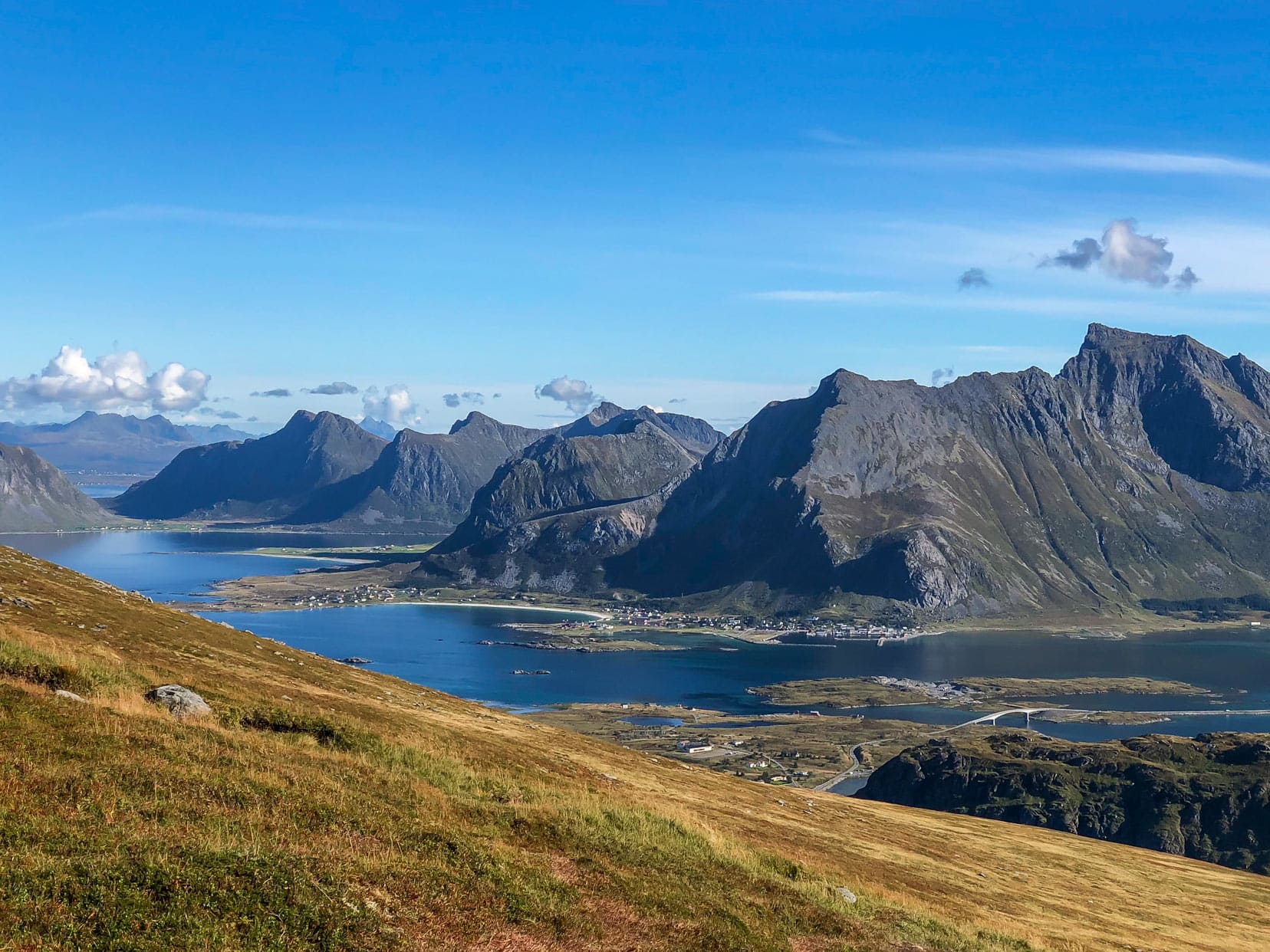
🥜 Lofoten 5-Day Road Trip Itinerary – In A Nutshell

Day 1: Å, Sund, Reine
Begin your journey in Å, the picturesque fishing village at the western tip of Lofoten. Explore its historic attractions, including the Norwegian Fishing Village Museum and the nearby scenic cod-drying racks.
Overnight: Reine
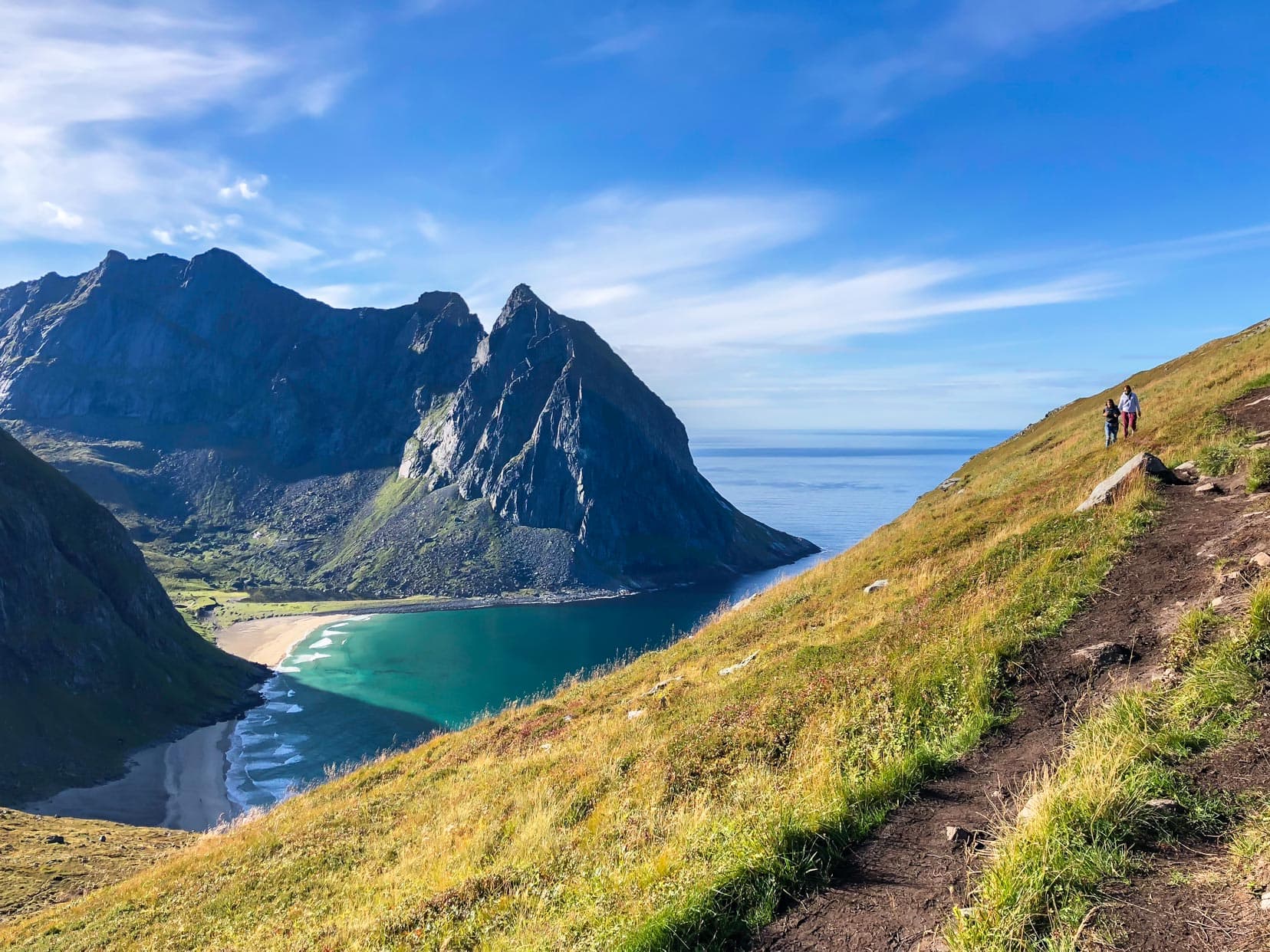
Day 2 – Ryten
Hike Ryten Mountain for breathtaking views of Kvalvika Beach, enjoying Lofoten’s stunning landscapes. Capture iconic photos from Ryten’s lofty viewpoint, akin to Trolltunga.
Overnight: Reine
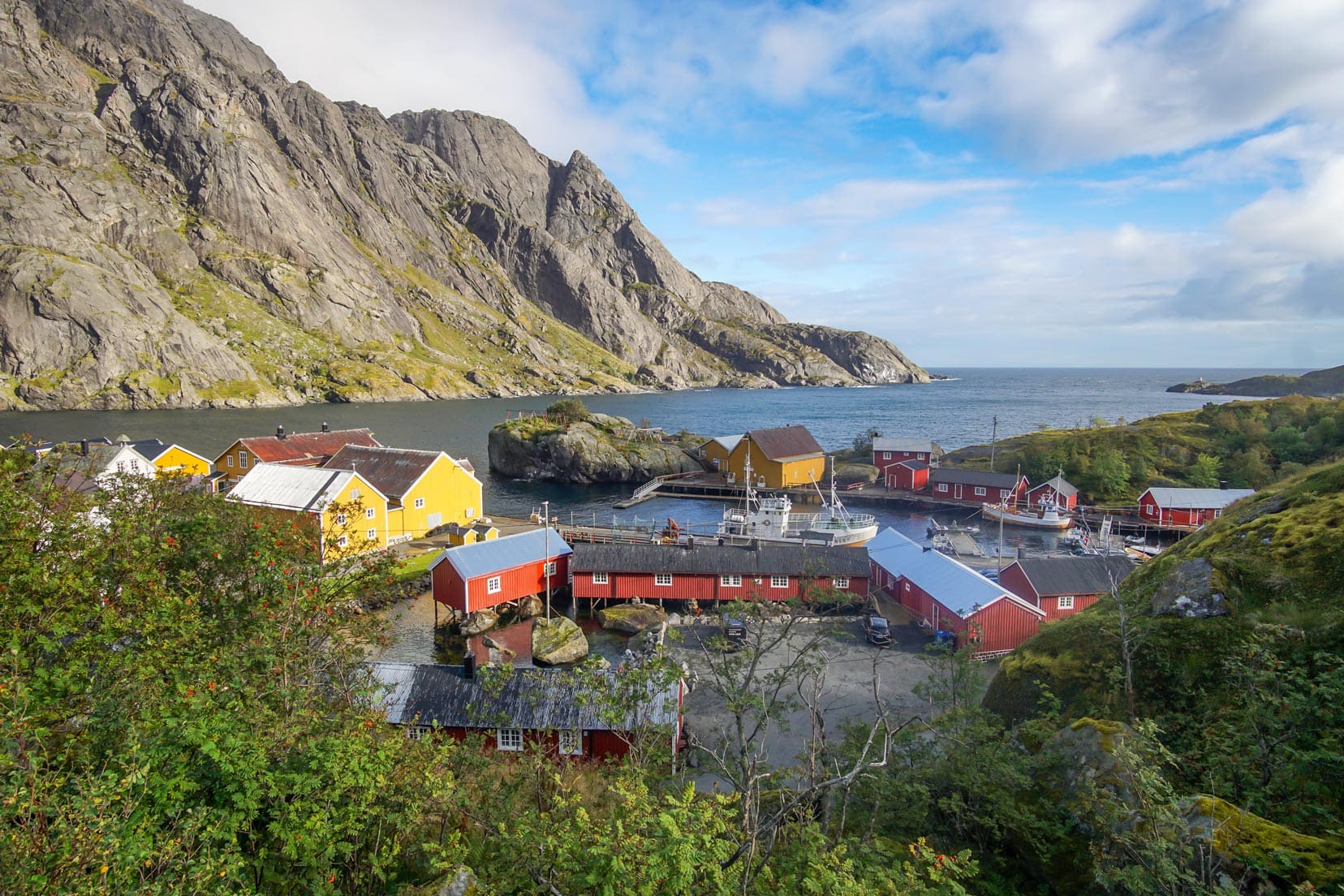
Day 3 – Nusfjord, Eggum, Ramberg, Henningsvær
Discover the charm of Nusfjord, one of the oldest fishing villages, and delve into its rich history. Enjoy the peaceful ambience and rustic beauty of its preserved rorbu cabins.
Overnight: Henningsvær
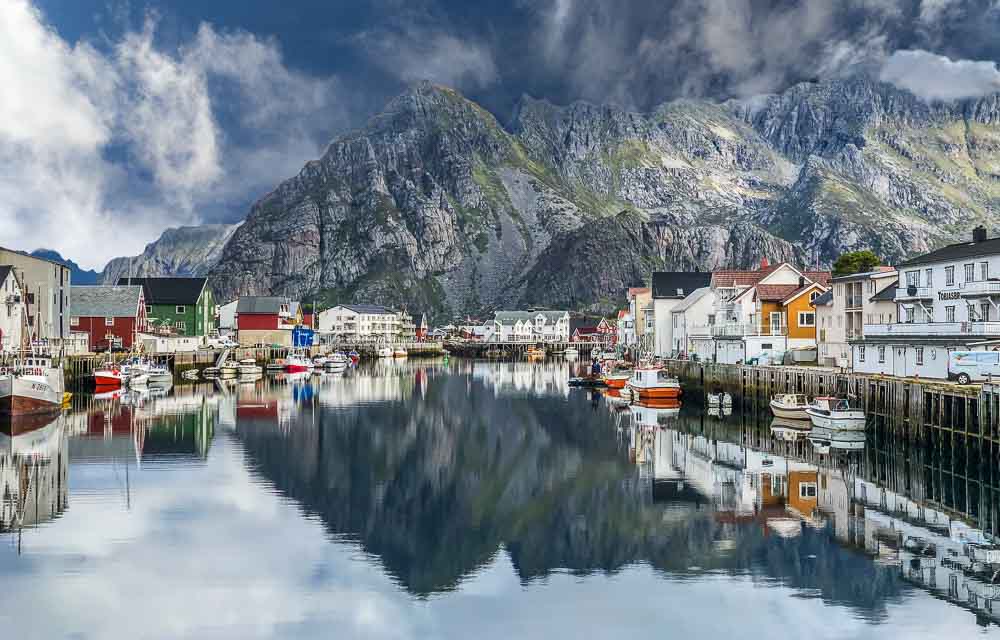
Day 4 – Henningsvær
Spend the day in Henningsvær, wandering through its vibrant streets lined with art galleries and waterfront cafes. Absorb the local culture and artistic atmosphere of this unique village.
Overnight: Henningsvær
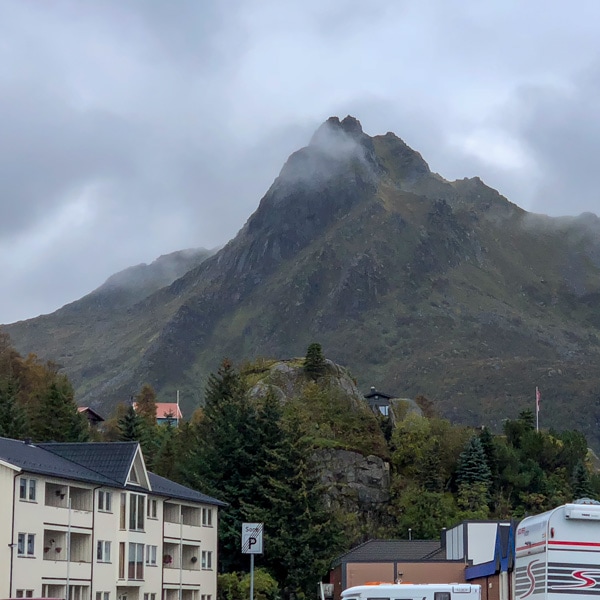
Day 5 – Svolvær
Drive to the dynamic town of Svolvær, the regional administrative hub. Explore its cultural sites, including the Lofoten War Museum, and experience the urban side of island life.
Overnight: Svolvær
Optional: Extra 2 days in Vesterålen Islands
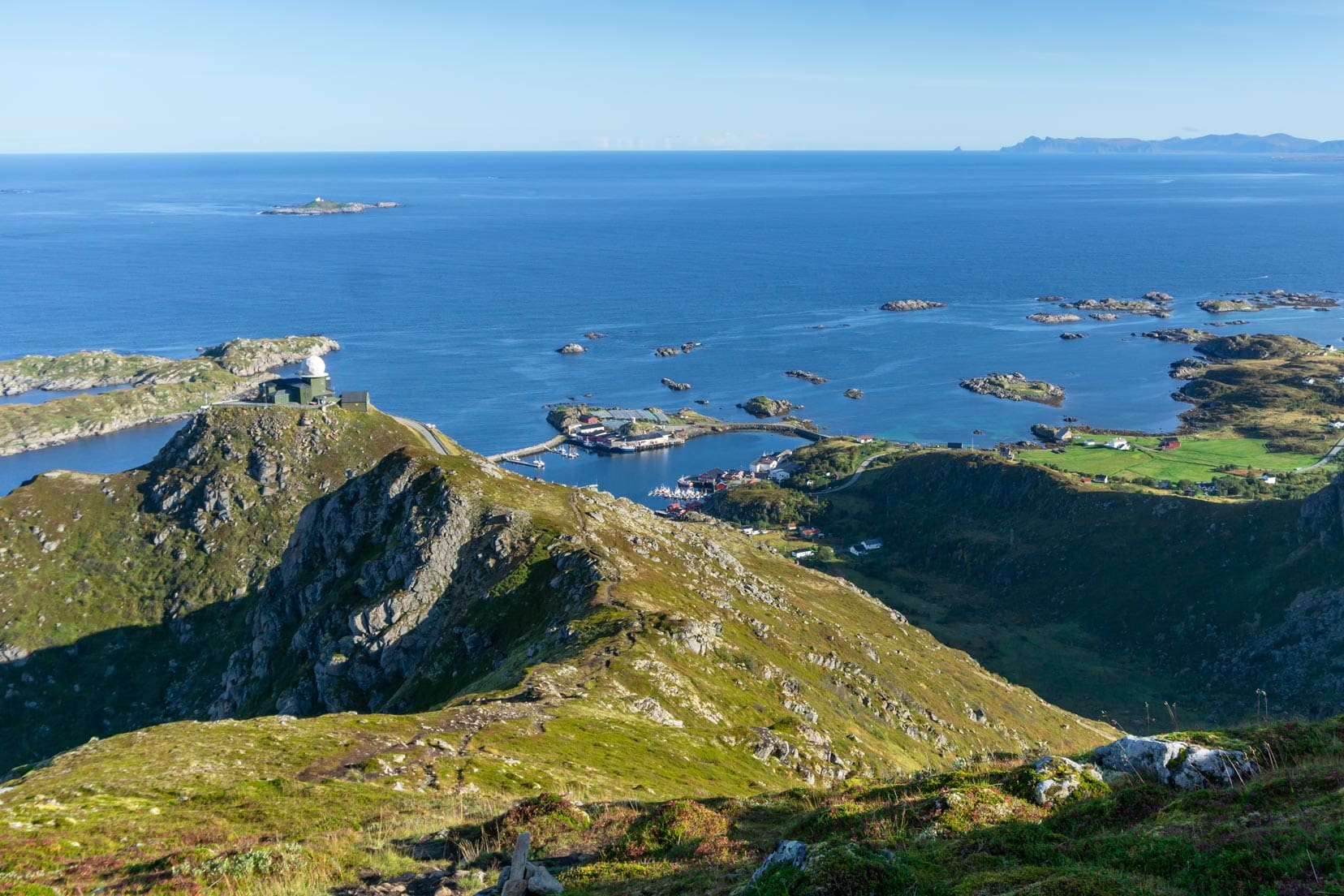
Day 6 – Nyksund
Hike Dronningruta, also known as the Queen’s Route, in Vesterålen. This challenging trail offers magnificent views of the coast and mountains. Finish your day by arriving in Nyksund, a once-abandoned fishing village revived by artists and entrepreneurs.
Overnight: Nyksund
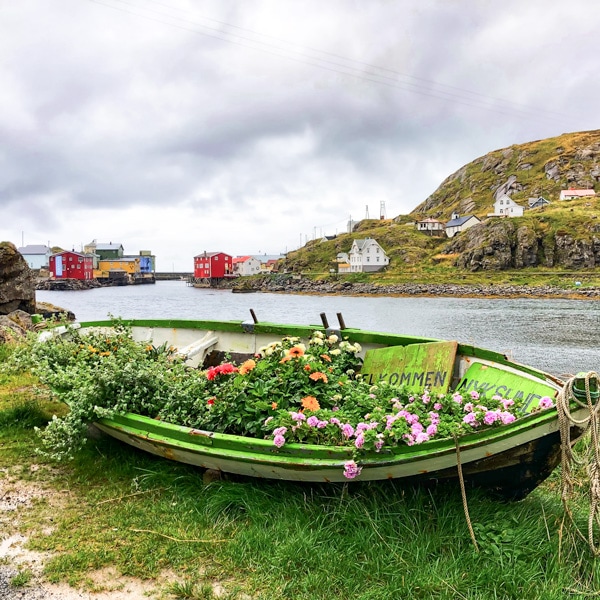
Day 7 – Nyksund, Narvik
Spend part of the day exploring Nyksund. Dive deeper into this unique village and enjoy the vibrant local culture, galleries, and cafes. Hike Dronningruta (optional). Depart for Narvik on Day 7 or the next day.
Overnight: Nysund or Narvik
Lofoten Islands Map: Scenic Route and Attractions
To use this map, expand it using the square symbol on the top right-hand side and then look to the key on the left-hand side. By clicking each location, you will find the corresponding position on the map.
- Blue Line marks the Norway Scenic Route Lofoten;
- Blue circles with a star denote an attraction;
- Home logo marks where we stayed overnight
- Yellow circles denote alternative options.

Lofoten 5-day Road Trip + 2 Days in Vesterålen Overview
Having finished the third leg of our Norway road trip, Trondheim to Bodø, we were perfectly poised to catch the car ferry for the 3-hour sail to Moskenes, a town in the western part of Lofoten.
Our five days to visit the Lofoten Islands was just the right amount of time for this road trip itinerary.
From Moskenes, our first stop would be Å, the westernmost village in Lofoten. From Å, we would keep an easterly route, traversing Lofoten’s islands from west to east, following the 230km Lofoten Scenic Route.
After leaving the Lofoten Islands, we turned north for two days in the Vesterålen Islands. I’ve included these two days as an ‘optional extra’ in this itinerary.
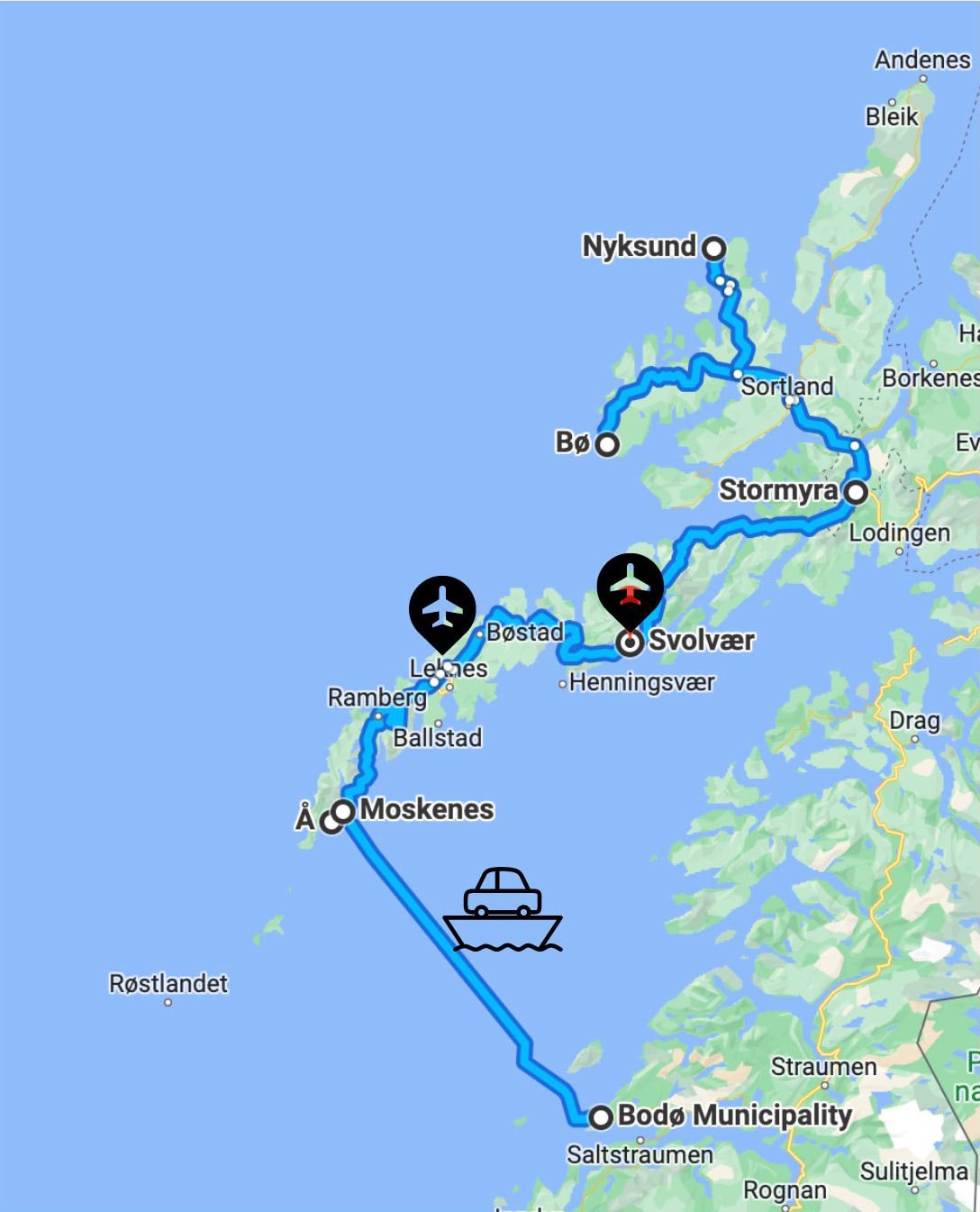
Planning a Trip to Norway?
- 🚗 Hiring a car? We recommend getting a quote from DiscoverCars
- 🚐 Hiring a campervan? We recommend Motorhome Republic
- ⛑ Arranged your travel insurance? Compare quotes from World Nomads & Safetywing
- 🪪 Order your International Driver’s Licence online here
- 🏩 Booked your accommodation? We use Booking.com to find the best deals
- 🐾 Is someone pet-sitting for you? 🐾 We use and love TrustedHousesitters
- (Get 25% off at checkout for new memberships with our discount code: LIFEJOURNEY25)
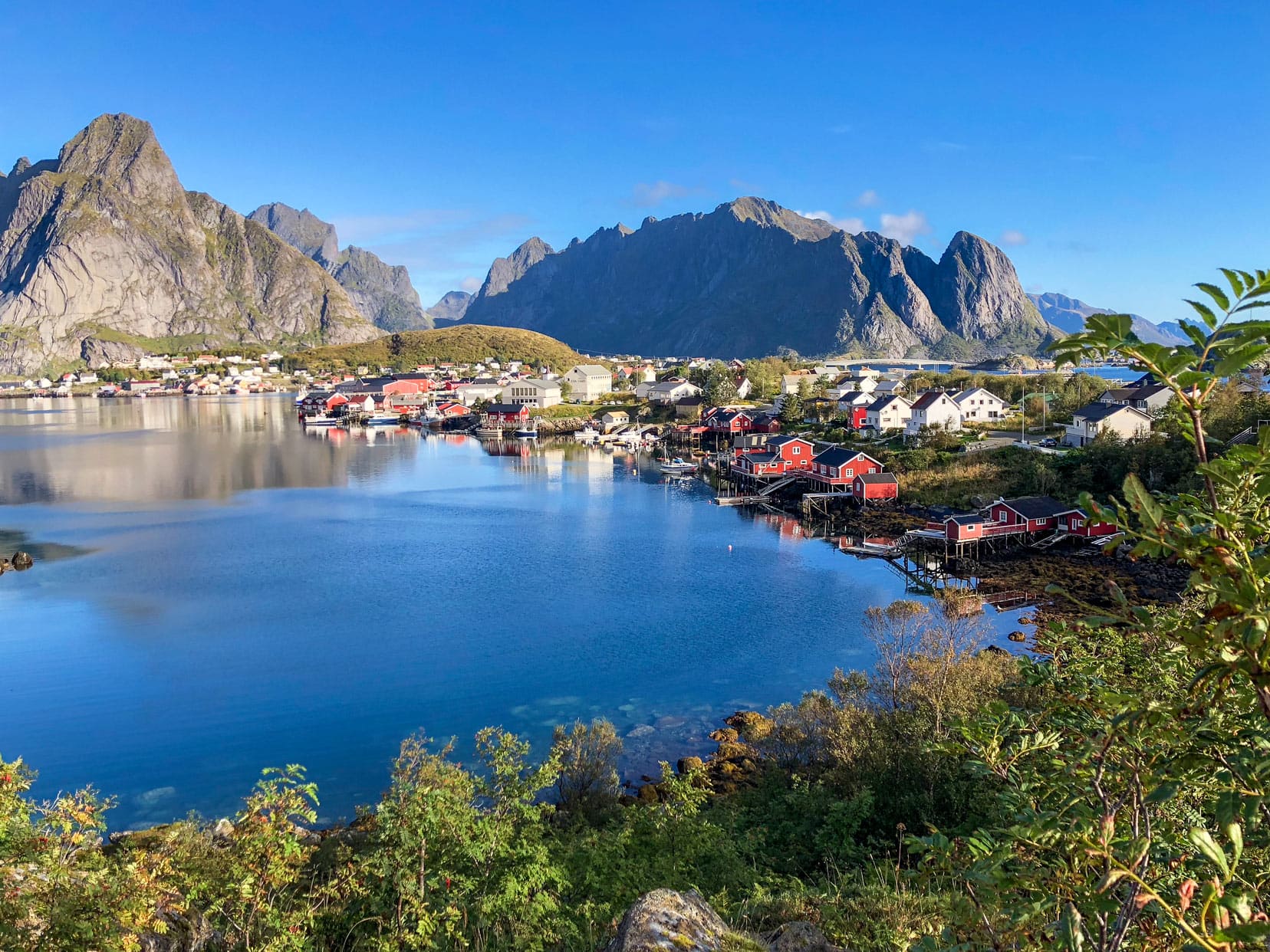
5 Day Road Trip: Lofoten Islands Itinerary
We kicked off our trip to Lofoten in the timeless village of Å, just 9km west of Reine.
Day 1: Å, Reine, Sund, Reine
Total kilometres: 53km
Overnight accommodation: Lofoten Bed & Breakfast Reine (we stayed here)
Å
The westernmost village in Lofoten, Å, is a well-preserved fishing village. Å is the last letter of the Norwegian alphabet, but it was our first stop on this epic Lofoten road trip.
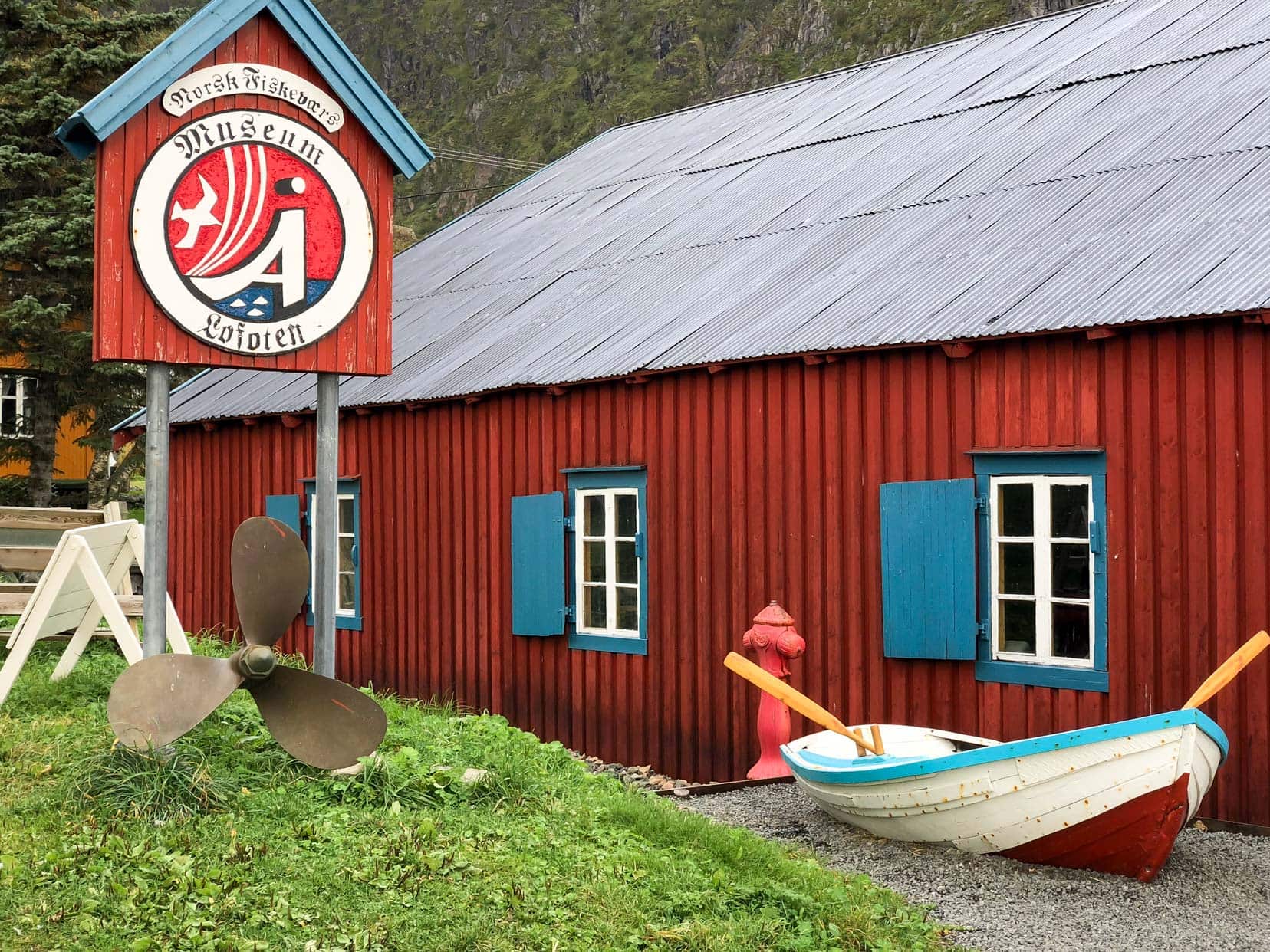
The Scenic Route Lofoten, starts at Å and ends in Raftsundet a distance of 191km. If you aren’t aware, Norway has a total of 18 panoramic drives throughout the country that showcase some of the most scenery in Norway.
This western end of Lofoten is renowned for its majestic landscapes. Don’t rush the drive; savour it all.
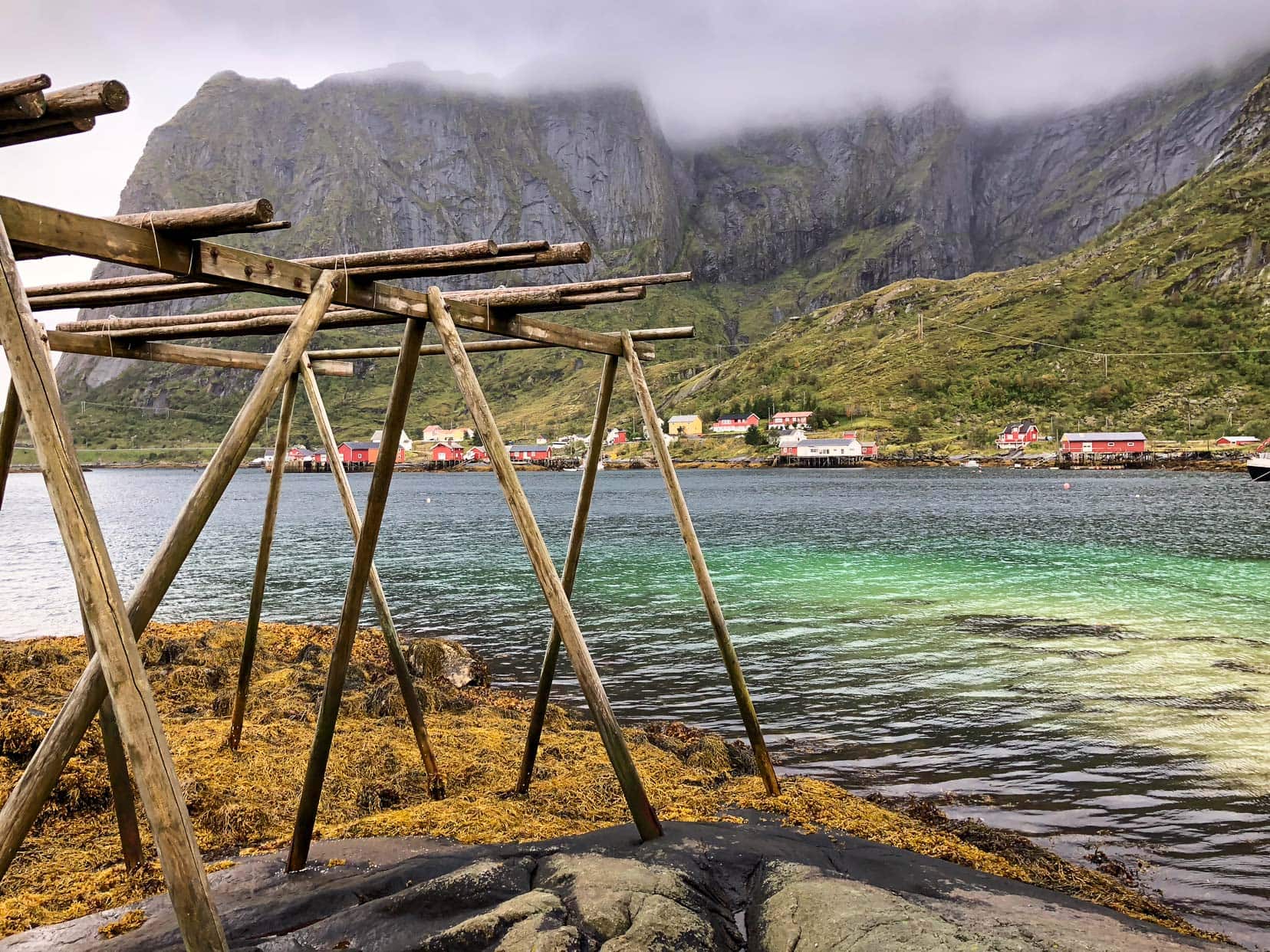
For over 1000 years, cod fishing has been the main economic resource of Å, but a relatively recent and major boost to revenue has come from the tourism sector. Now, Lofoten hosts more than one million visitors every year.
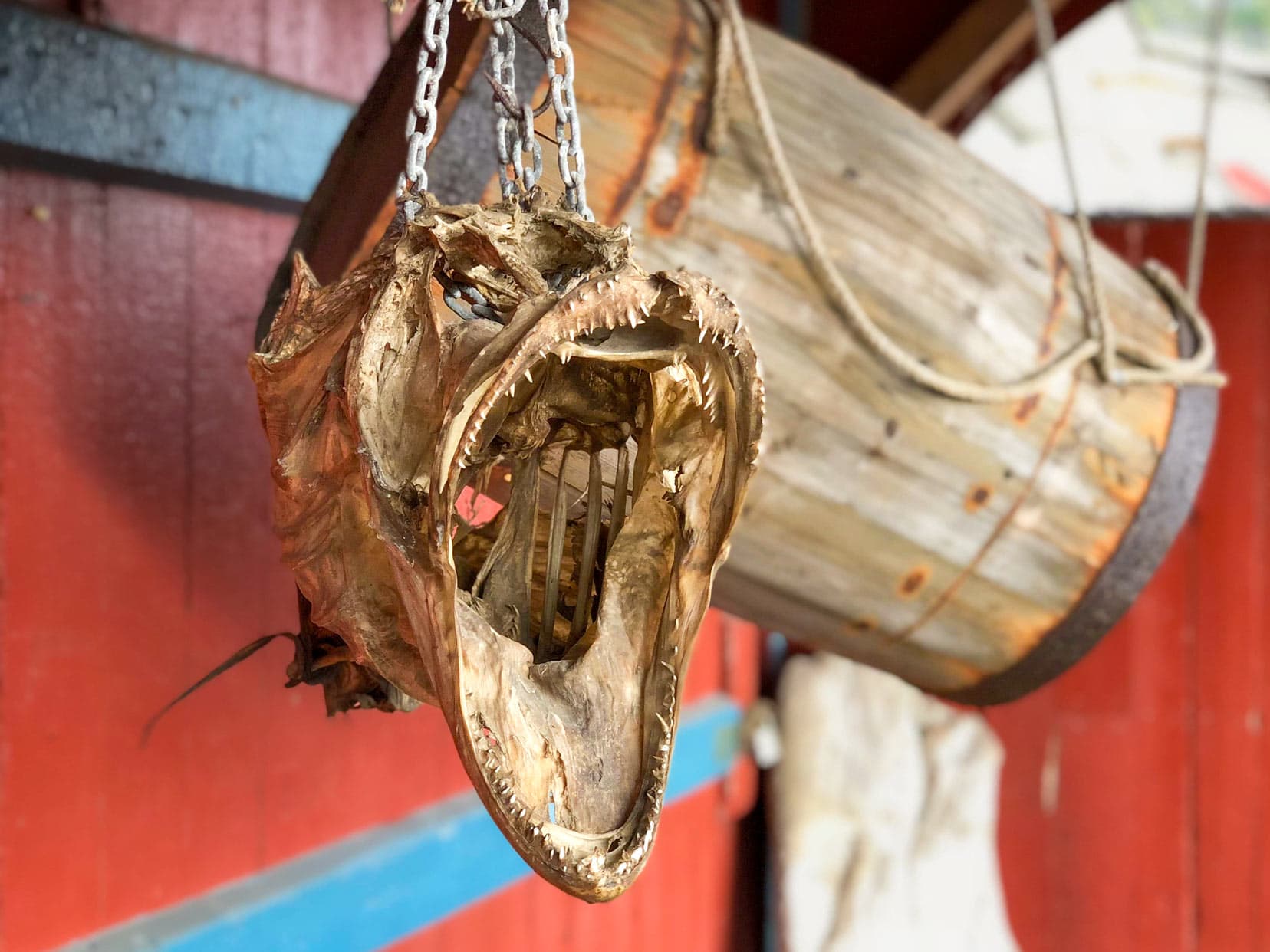
Part of this popularity followed the launch of the children’s movie Frozen, with Norway’s landscapes providing much inspiration for the movie.
Museums in Å
There are two museums in Å, the Lofoten Fishing Village Museum and the Norwegian Stockfish Museum.
The Fishing Village Museum consists of a walk-through of the village of Å admiring the interesting late 18th-century buildings. Many have information boards (in both Norwegian and English) explaining the purpose and any important details.
Fishing Village Museum Opening Hours by Season:
- Winter (02 January–31 May)
- Monday–Friday: 11:00–15:00
- Summer (01 June–30 September)
- Open daily: 10:00–18:00
- Autumn (01 October–07 December)
- Monday–Friday: 11:00–15:00
Closed on:
- 01 January; 28-29 March; 01 April; 1, 9, 17-20 May
- Annual Closure: From 08 December to 02 January.
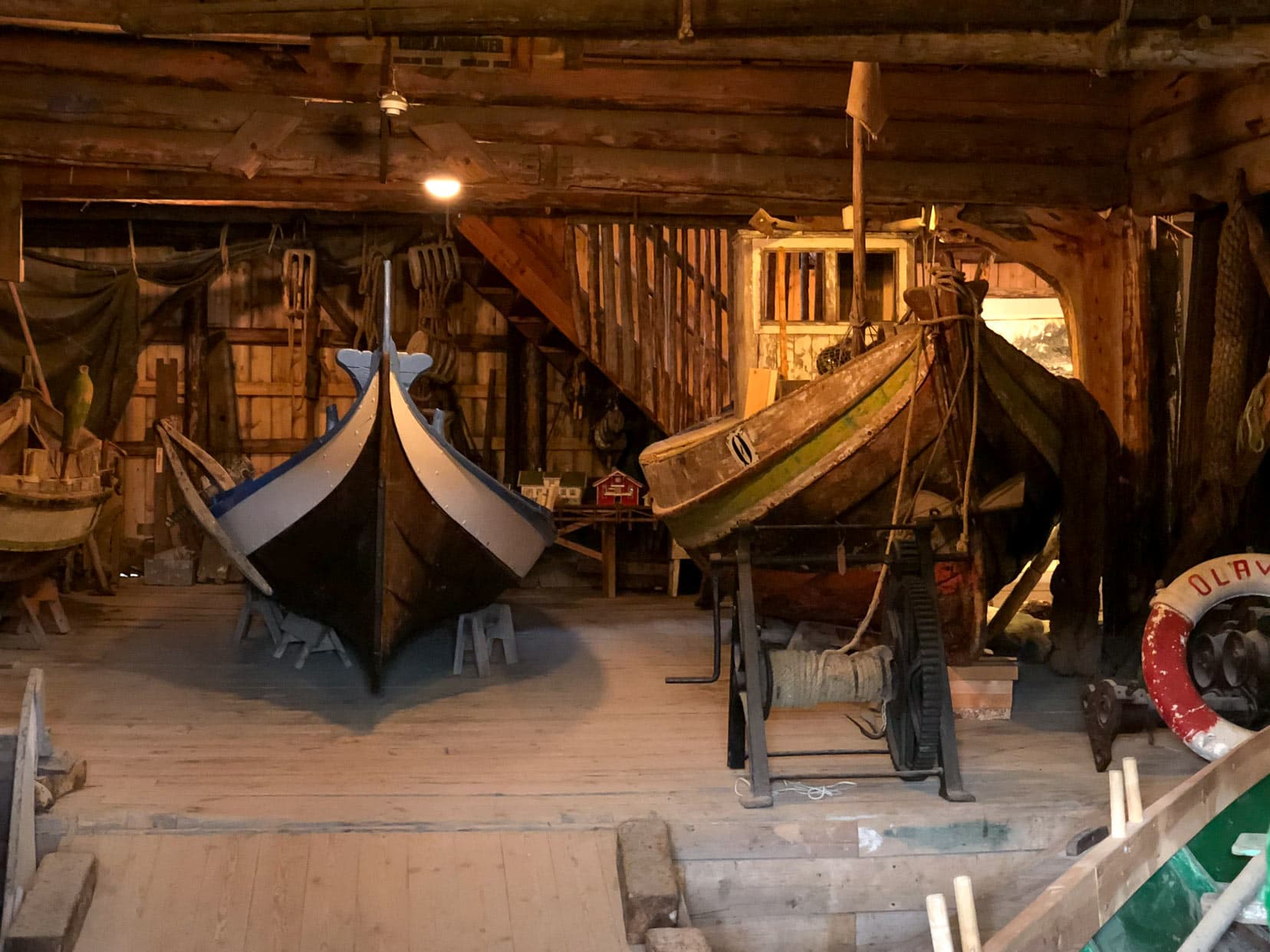
The Norwegian Stockfish Museum is dedicated to the methods used to the landing and processing of the stockfish and the export of Norway’s lucrative commodity, Cod.
The Norwegian Stockfish Museum is open in the Summer (June–August).
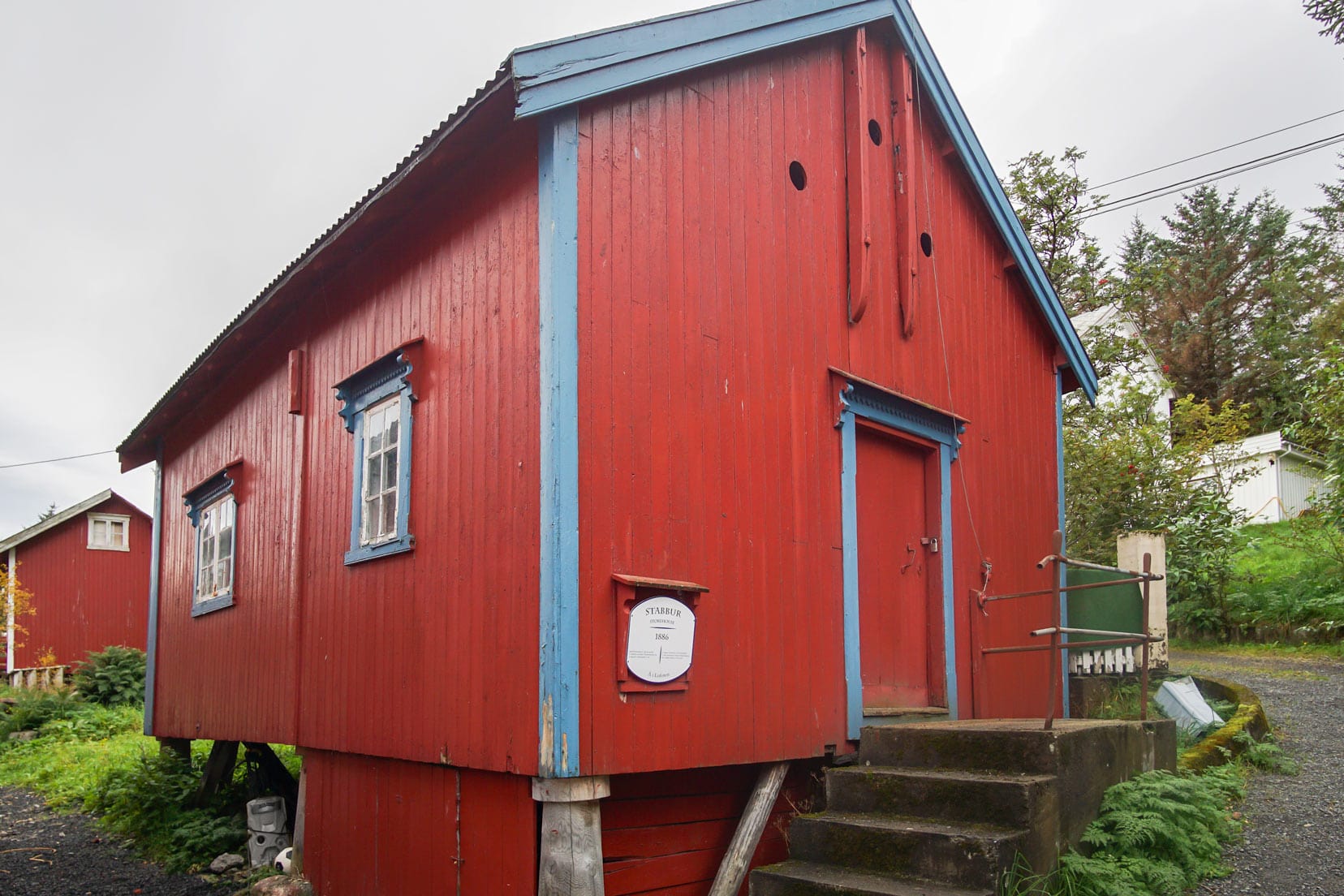
Hike to Agvatnet
We took a rather slushy walk to Ågvatnet, a lake close by Å, to hunt for some geocaches.
On this hike, we encountered our first whiff of dried cod. Tracking down the source, we discovered hundreds of cod heads stacked in a shed behind wooden cod-drying trellises.
Why these dried heads are kept remains a mystery to us. The smell was quite punchy and managed to cling to the nostrils for quite some time.
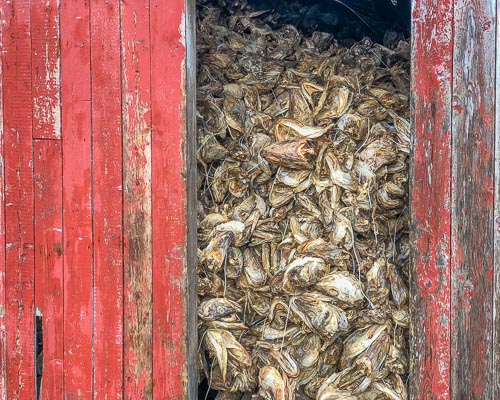
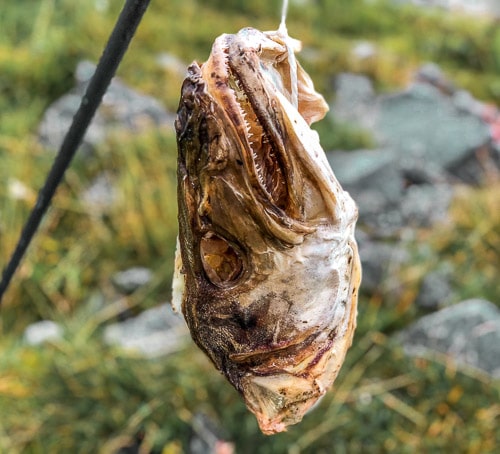
Keep An Eye Out For
Robru (fishing huts): To get a different feel for the village, walk down to the town’s small harbour. Captivating yellow and red coloured Robru (fishing huts) hug the shoreline opposite rugged mountain slopes; just fabulous scenery.
Corner Store: While in Å, pop into the village ‘corner store’, which is worth a wander if only to see the local souvenirs and cod displays.
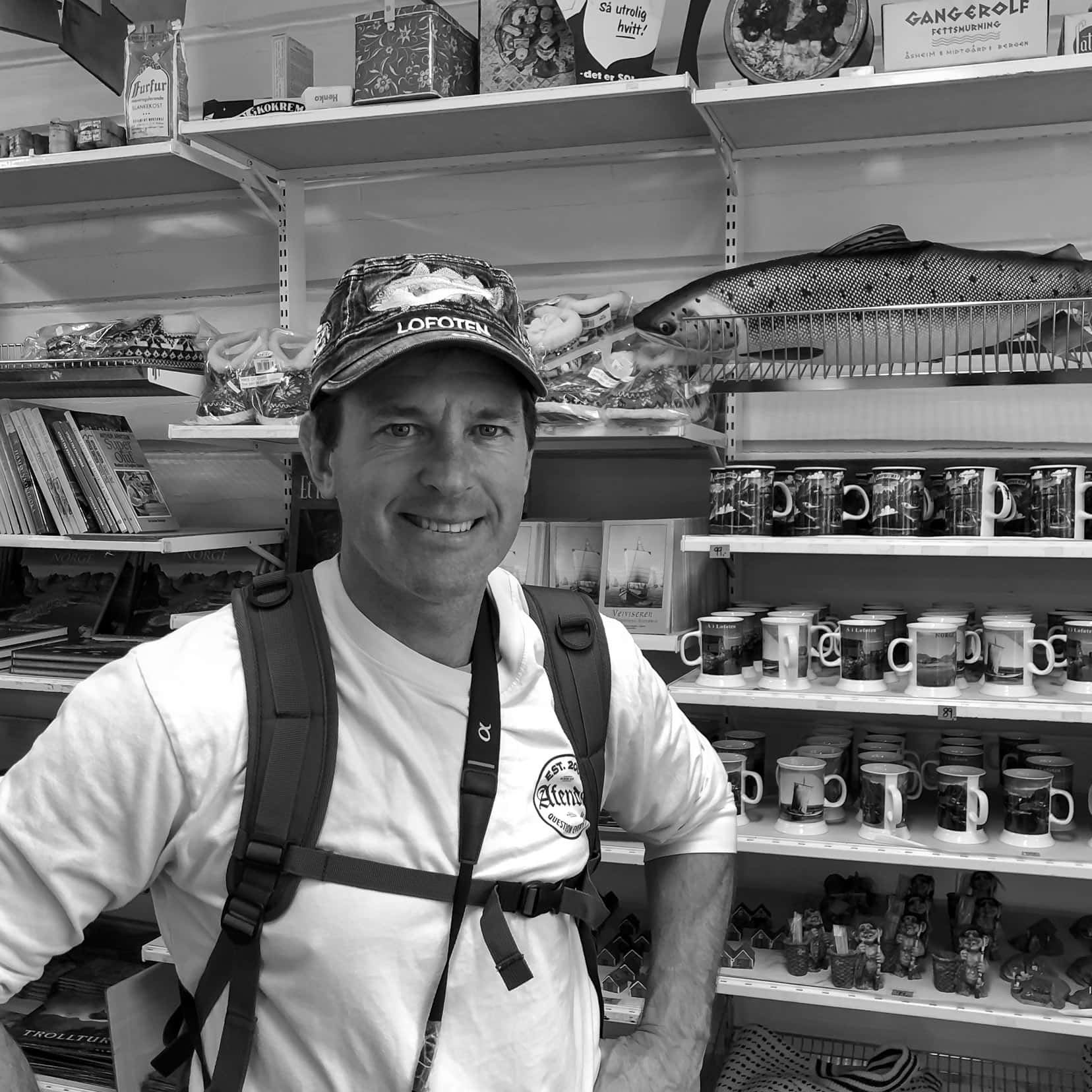
Sund – Historic Blacksmith Workshop
Leaving Å, drive 26 kilometres past Reine to reach Sund. Here, the renowned blacksmith Tor Vegard Mørkved owns and operates both the blacksmith’s workshop and the Sund Fisheries Museum.
What you see and the techniques used at the smithy have remained unchanged since 1947, when Tor Vegard’s mentor, Hans Gjertsen, started the business. A museum was also launched in 1947, with the official opening in 1964.
Tor Vegard is a fantastic host. He gave us a detailed talk on his past and the workshop’s history. He then brought his furnace to life to fashion a steel cormorant, swearing by his old but reliable machinery, which dates back to the start of the 20th century.
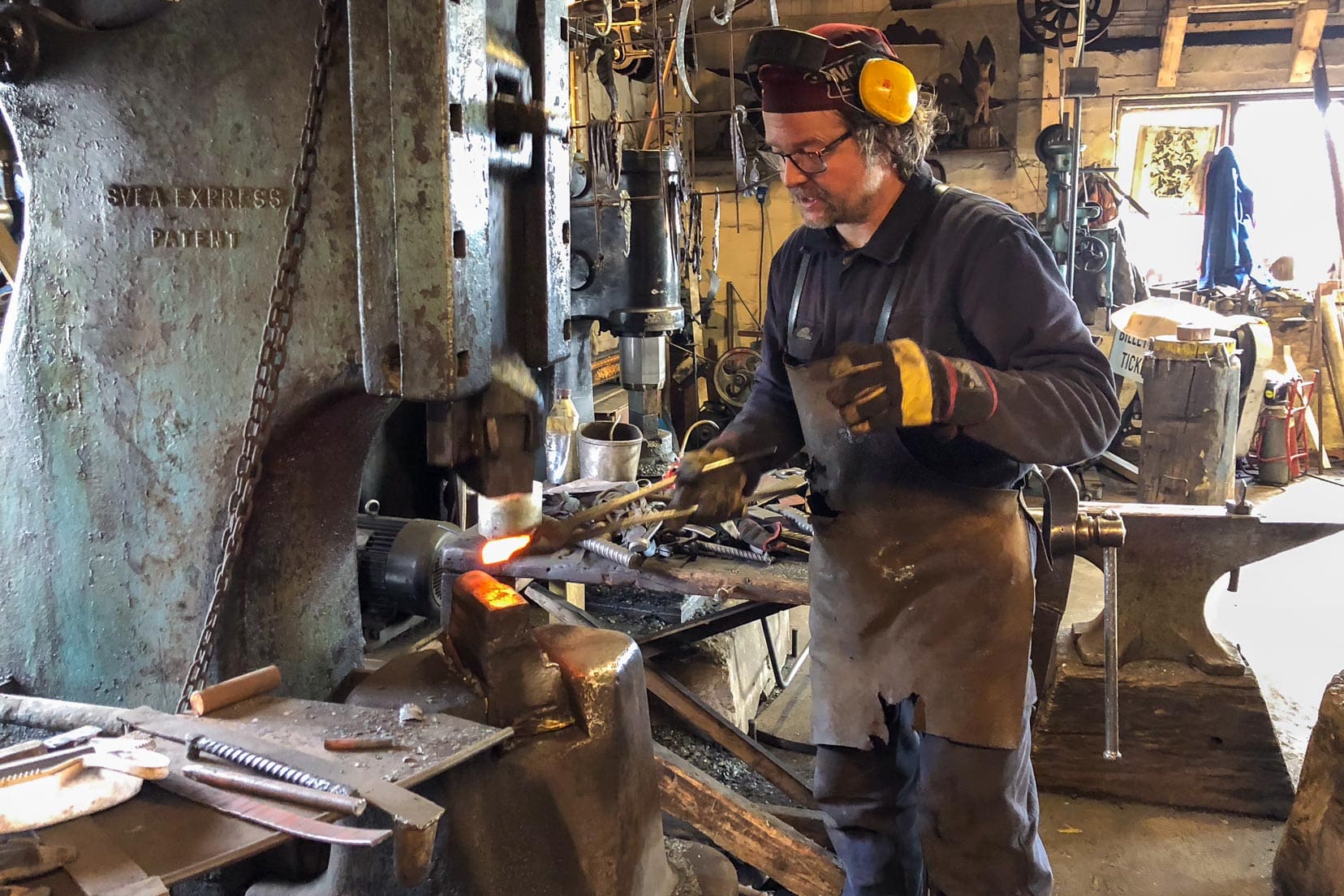
We asked him why he makes cormorants and not some other bird. He said it was because the cormorants roost on the rocky outcrops here, and to him, they represent the spirit of Lofoten … plus he really likes their look.
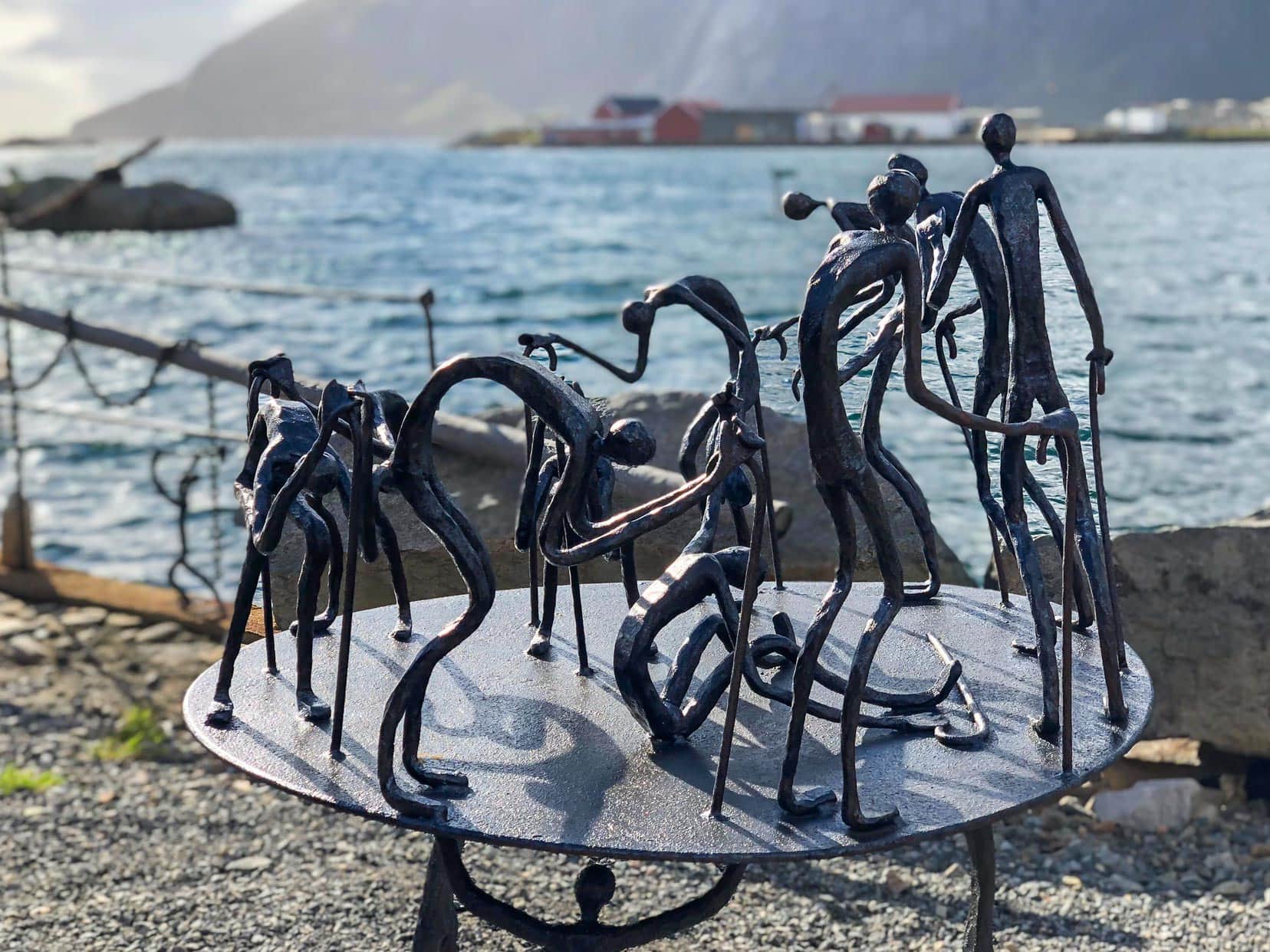
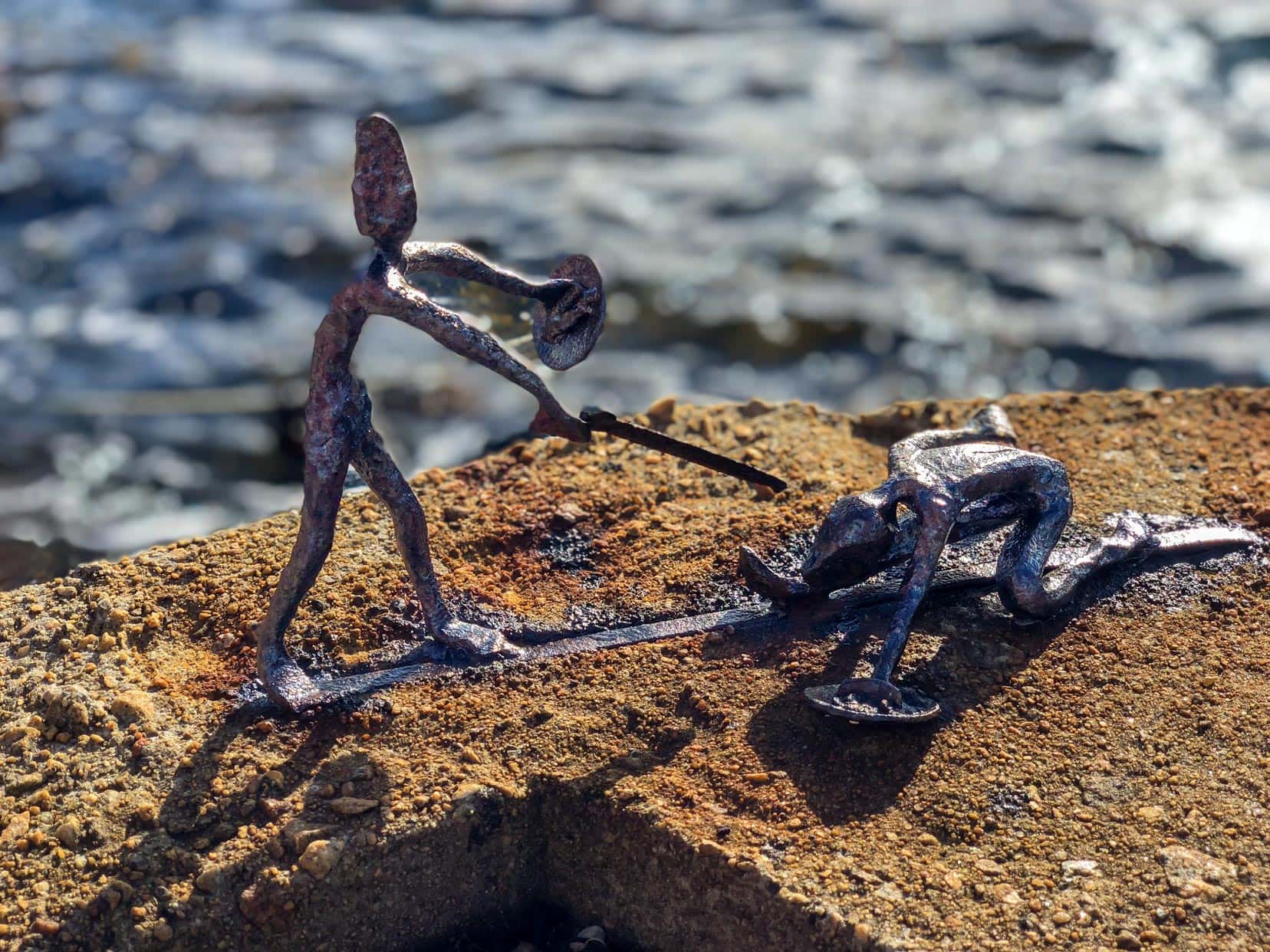
In the museum grounds, old fishing boats tell their own stories of a hard life, along with the motors that used to power them.
Tor Vegard told us that he wants to retire and would like to train an apprentice to take his place but as yet, no one has stepped forward. You can see this master craftsman in his element below.
Video of Tor Vegard at work in Lofoten’s historic blacksmith premises:
Reine – Capturing the Northern Lights
On our drive back towards Reine from Sund, we were looking for suitable locations to photograph the Northern Lights. With favourable predictions for their appearance, we wanted just the right spot with a great backdrop.

We found such a place just outside of Reine. The location offered elevation above possible bright light sources and mountainous surroundings.
We’ve written a separate comprehensive article on Unveiling the Northern Lights in Lofoten, but know that the gods did favour us and we witnessed the dancing and shimmering lights we so longed to see.
What a start to this Lofoten road trip.
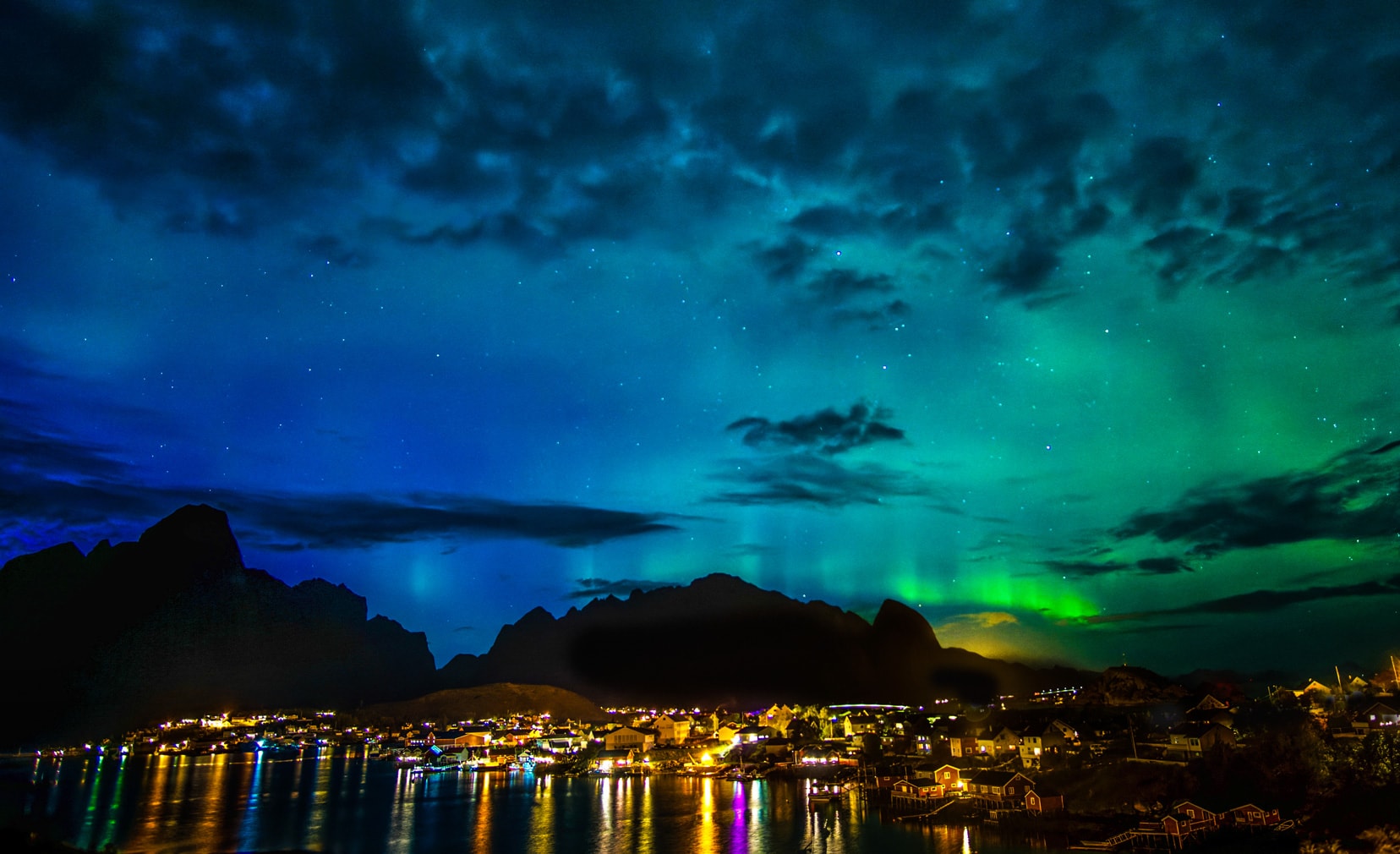
We had a great stay at Lofoten Bed and Breakfast and can recommend them along with more than 1400 positive reviews.
Video: Taster of this Lofoten Road Trip
A 3 ½ minute video showcasing the magic of the Lofoten Islands.

Day 2: Ryten
Total kilometres: 52 km
Overnight accommodation: Lofoten Bed & Breakfast Reine
Ryten Hike With Views over Kvalvika Beach
The Ryten hike is a fabulous three-hour climb (up and down) to the top of Ryten Mountain, which boasts wonderful views, including those of the white, sandy Kvalvika beach, 500 metres below.
It even has a natural rocky ledge where you can perch for a selfie and capture those beautiful panoramic views.

It’s one hike you should strongly consider when in Lofoten. It’s relatively short in distance and has grandstand views all the way. The hike is rated as easy.
Want to know more?
We’ve written a separate article on this hike; Ryten Lofoten – Incredible Hike Above Kvalvika Beach, which includes photos, the hike, parking… basically, all you need to know.
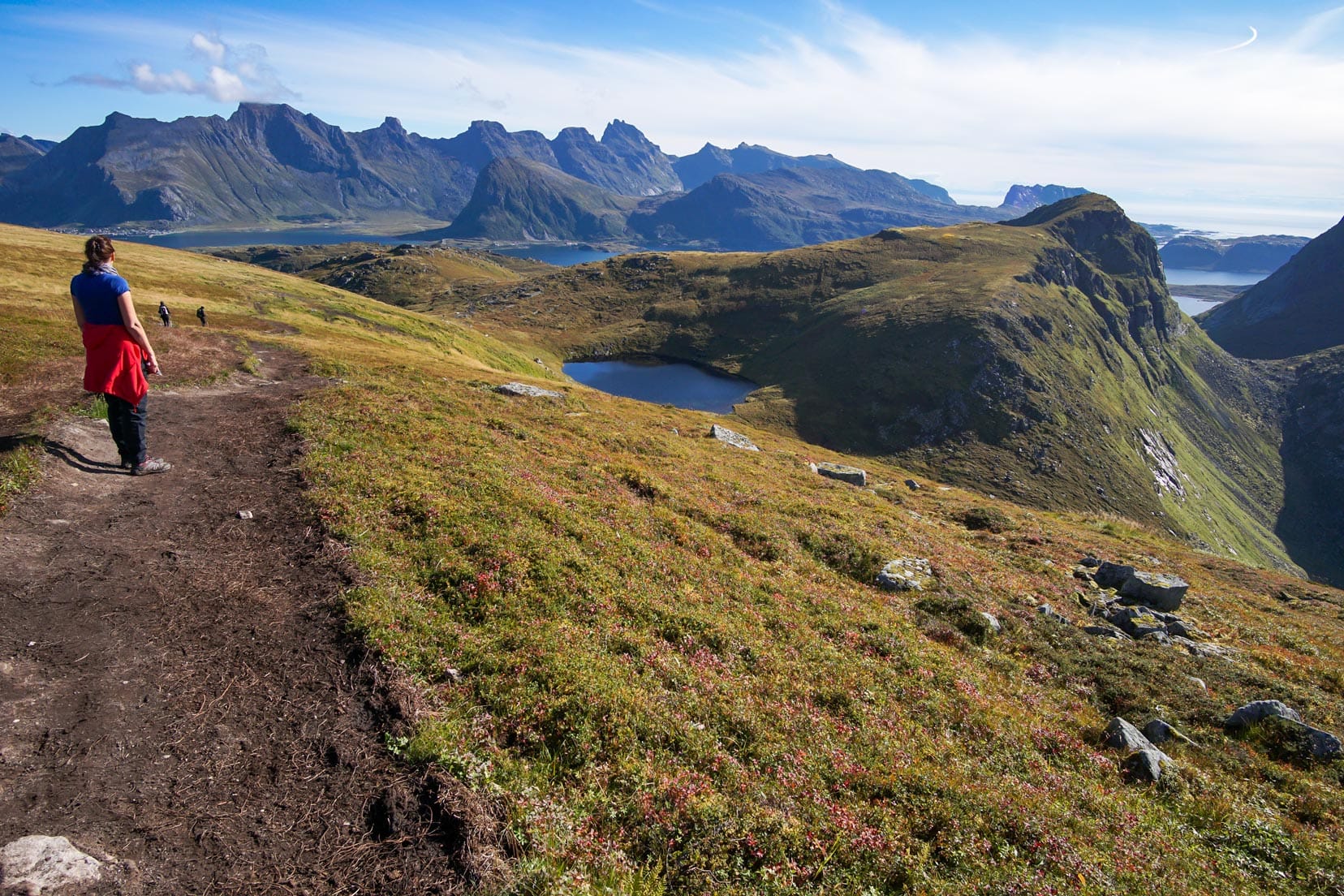
As mentioned, we made sure to stay at least two nights at each accommodation.
Day 3: Ramberg, Nusfjord, Eggum, Henningsvær
Total kilometres: 143 km
Overnight accommodation: Lysvolbrygga
Departing Reine, our first stop was Ramberg Beach.
Ramberg Beach
Why visit a beach inside the Arctic Circle? Just take a look.
Ramberg Beach is located 15 kilometres north of Nusfjord and is renowned for its long stretch of pristine, white sand that gently curves around a bay of bright blue-green water amongst towering mountains.
It’s something special.
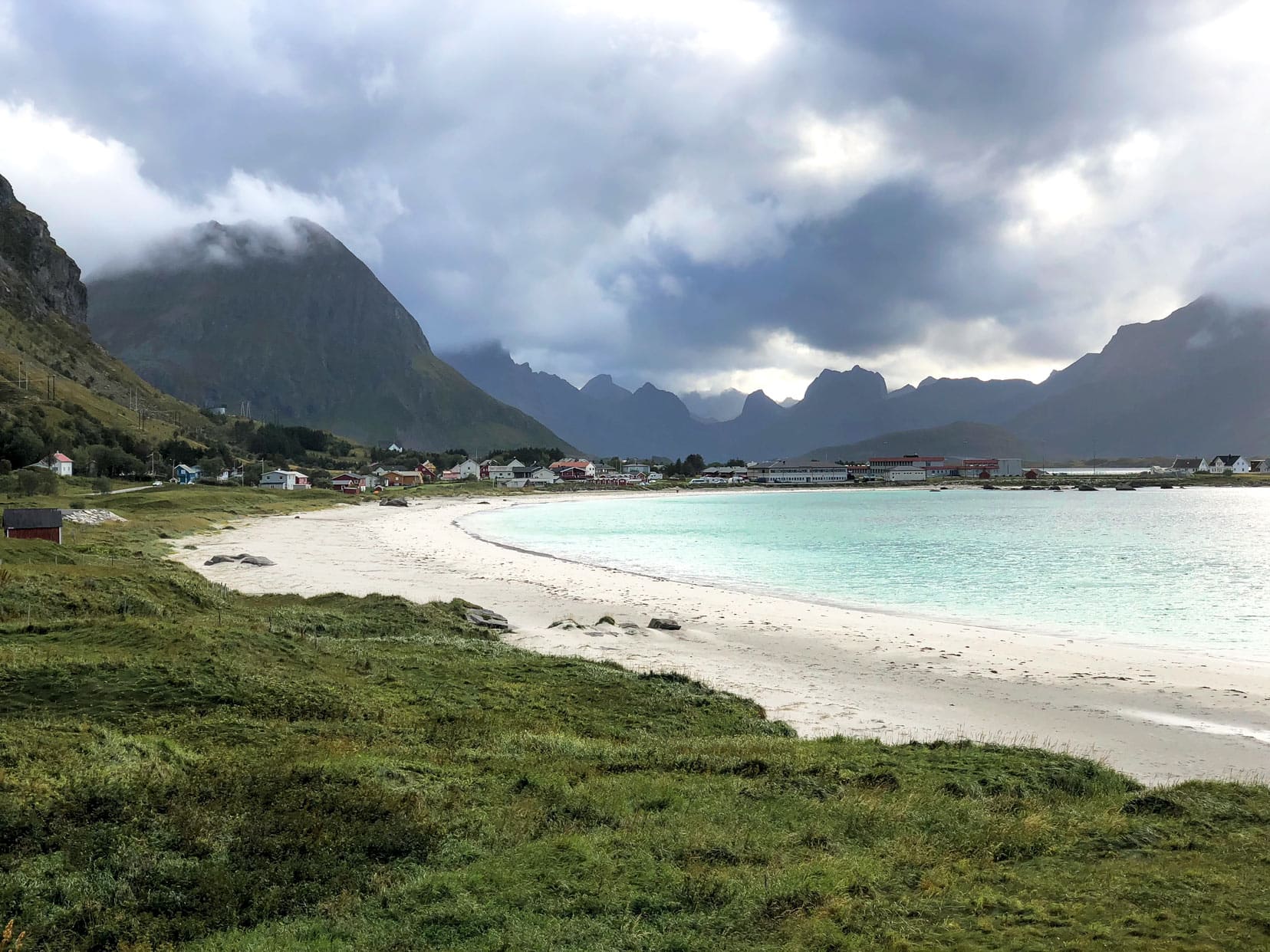
There is parking close to the beach, so in mere minutes, you get to feel that white sand under your feet. It could easily be a place of contemplation.
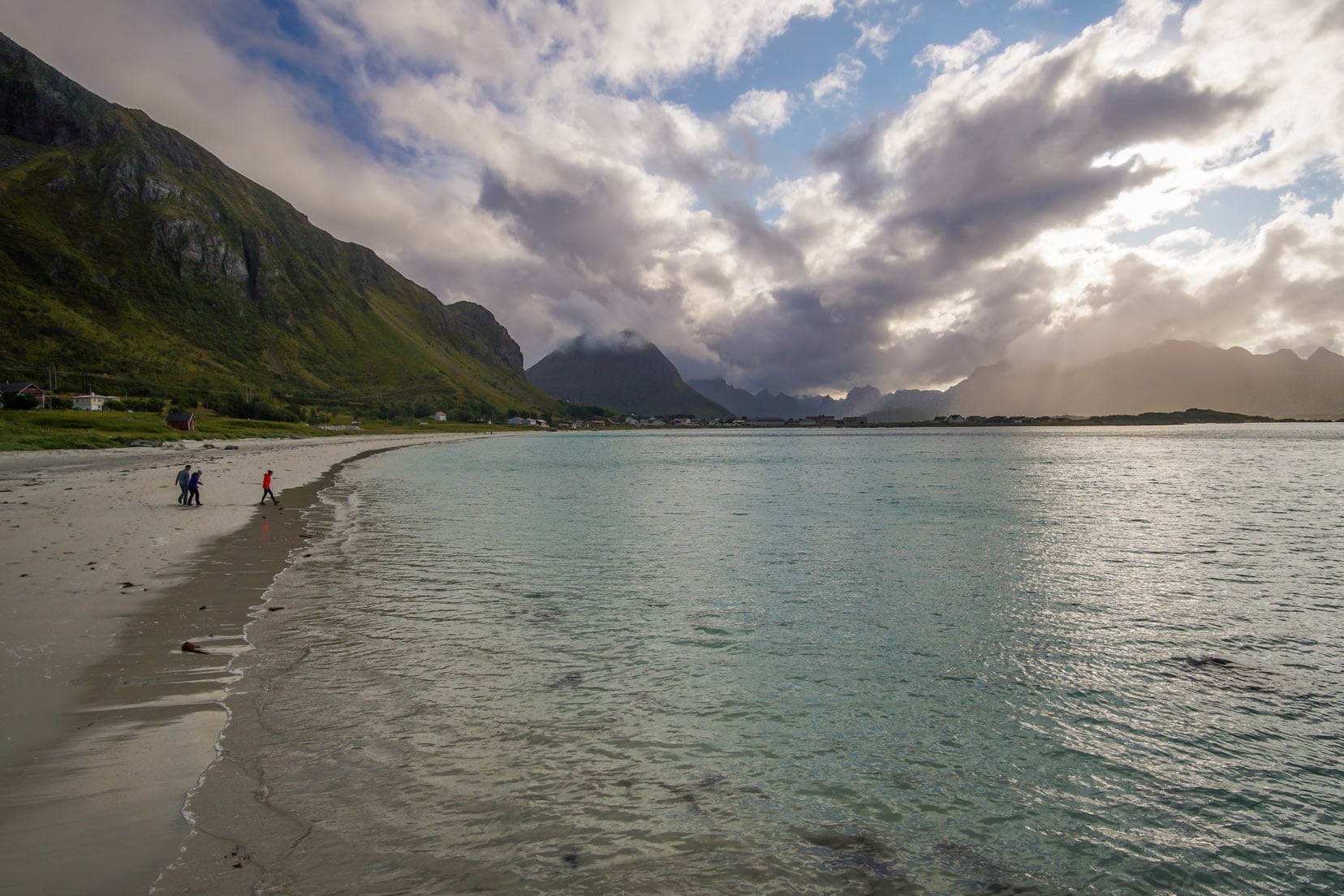
Nusfjord
This beautiful, picturesque little village lies on the southern shore of Flakstadøya island, 40 kilometres east of Reine. It claims the title of one of the oldest traditional fishing villages in Norway.
In fact, signs of human existence have been traced way back to 425 BC. Say what?

This secluded harbour is home to a handful of renovated buildings including rorbu or old cabins used by fishermen that are often transformed into cosy accommodation spaces.
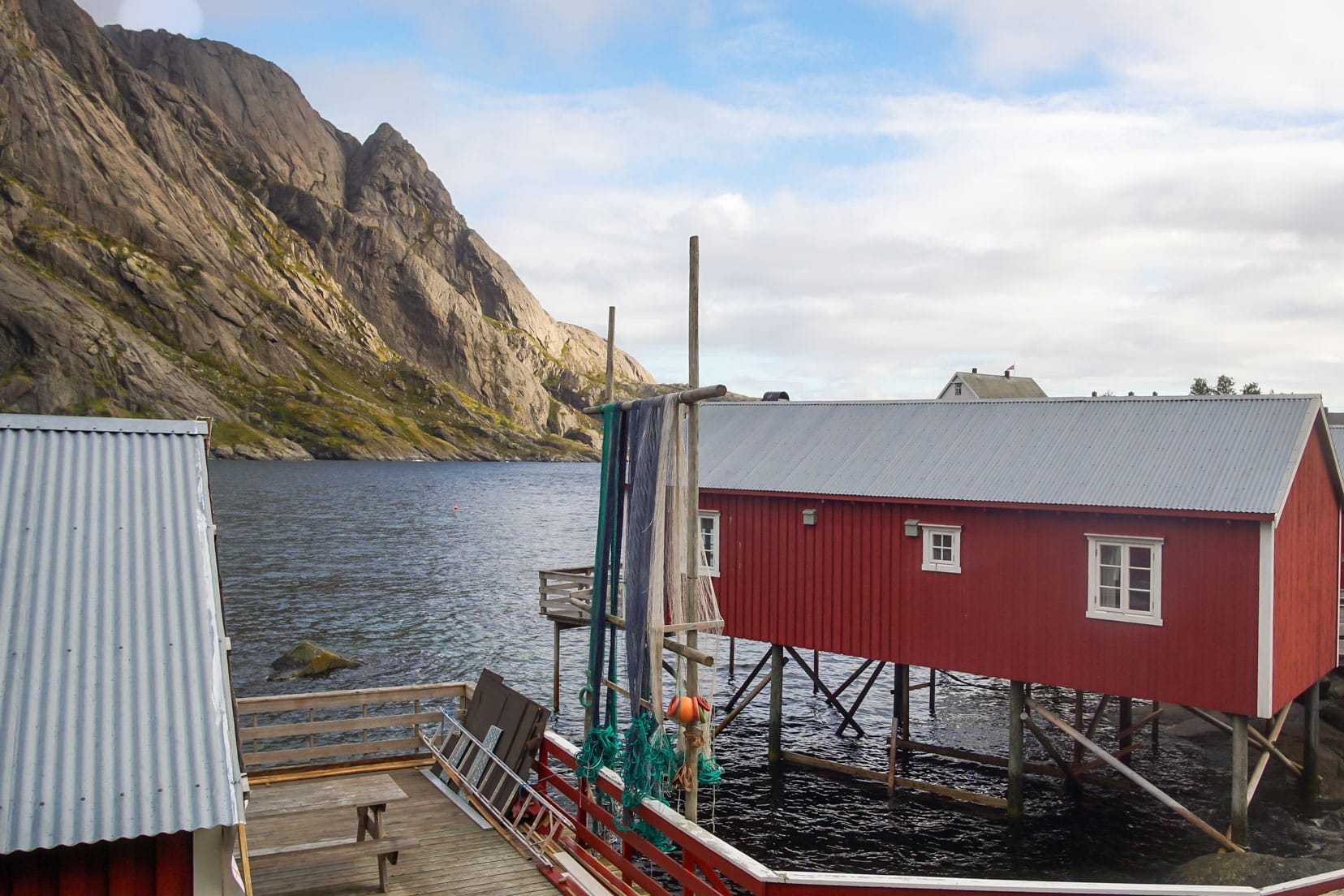
The first road to Nusfjord was only built in the 1960s. Here in Nusfjord, there are no new buildings, so you get to step back in time and experience the Lofoten of old.
Eggum
Now for a change of pace and something different. Are you familiar with art by Skulpturlandskap Nordland?
These are works of art found in northern Norway, constructed by international artists who produce their creations based on how the natural environment inspires them. Lofoten has 6 works of art.
One is found just outside of the village of Eggum, on the island of Vestvågøy. To get there, follow the road Eggumsveien until it ends at a car park. Down a path that divides a pristine lake with jagged mountains from a wild, rocky shoreline is where you can find ‘Head’.
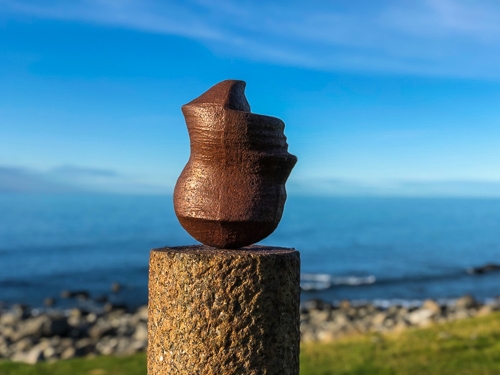
Meet Head. This granite and iron construction is cleverly thought out. Viewing the sculpture from a different angle shifts the perspective from an upward-facing face to down.
It’s something else.
Head is representative of the varying colours and surfaces of the water and landscape in the area. It is definitely a thought-provoking piece of work in such a serene location.
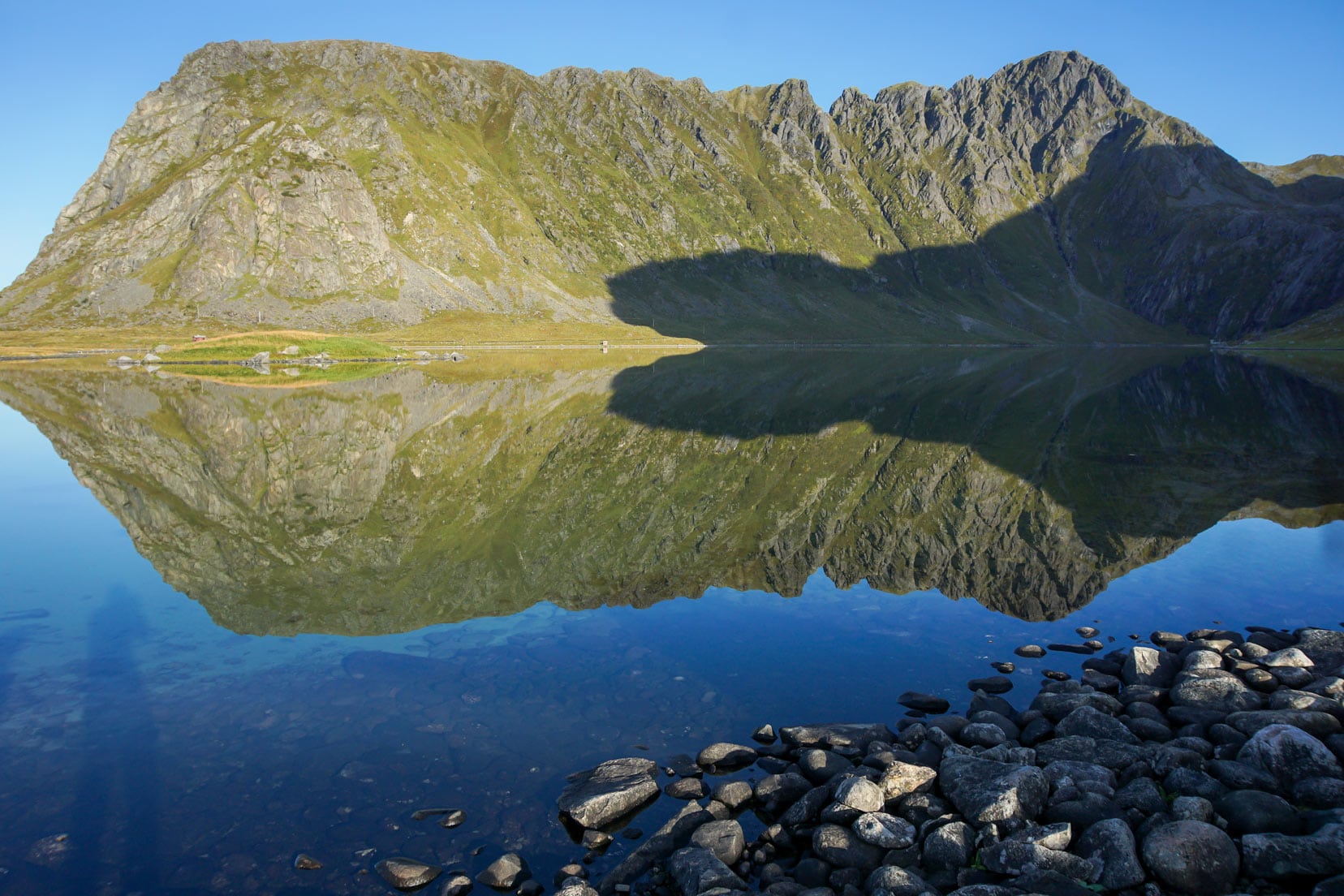
Leaving Vestågøy for Austvågøya island, we stop to admire a last sculpture, ‘Uten Tittel’ before reaching Henningsvær.
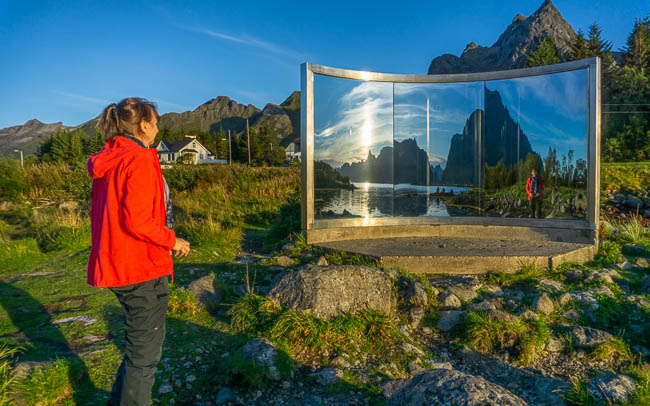
Consisting of two huge concave mirrors (2.5m x 3.0m), it reflects the surrounding water and mountains beautifully—another example of great creativity.
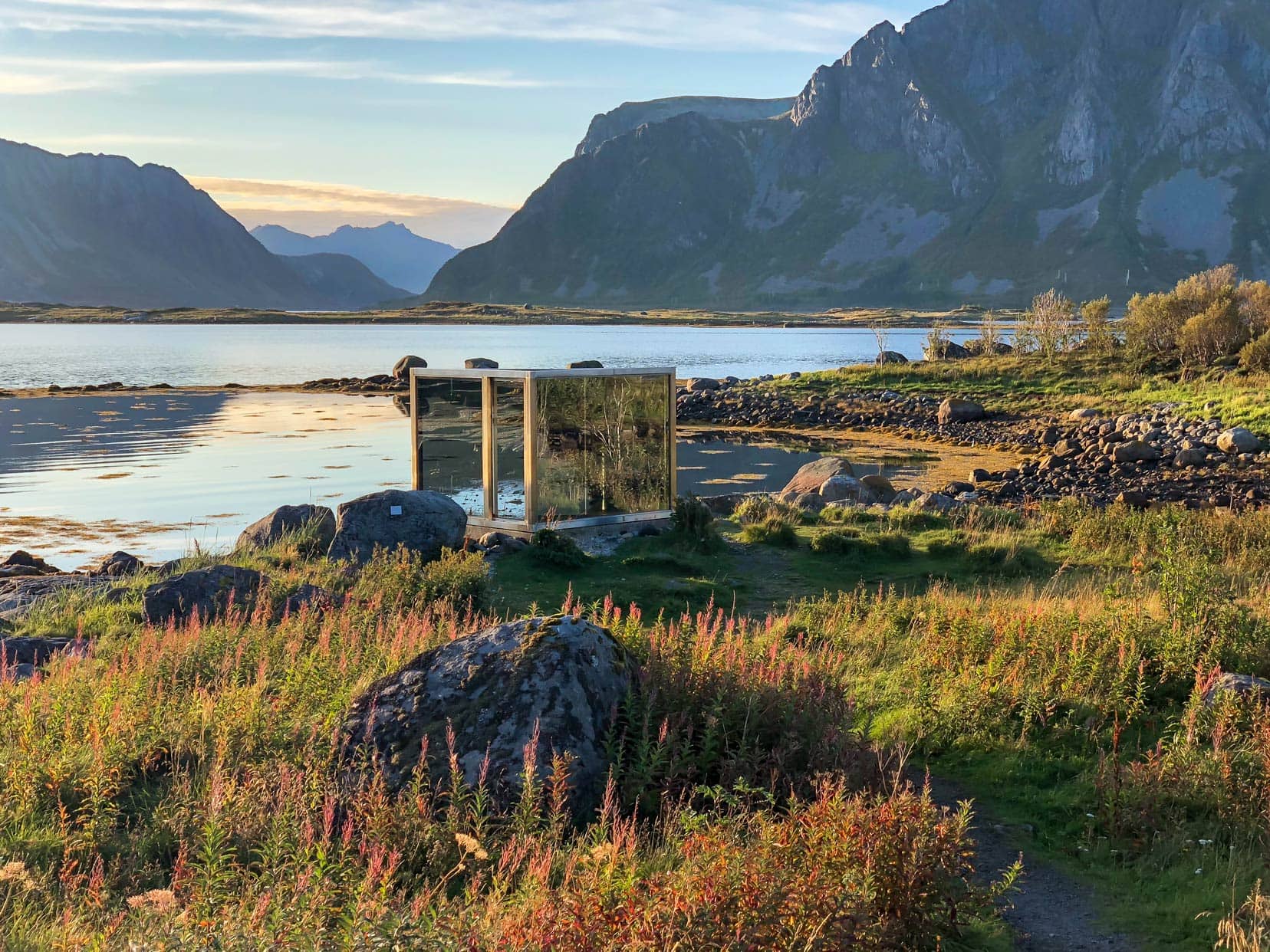
Henningsvær
Tonight’s stop is the picturesque, traditional village of Henningsvær and our most wonderful stay at Lysvoldbrygga.
Day 4: Henningsvær
Total kilometres: 0 km
Overnight accommodation: Lysvolbrygga
Henningsvær
Today, we don’t travel and spend the day on foot, exploring Henningsvær.
The town itself is spread over several islets, which are easily accessible via quaint bridges. We used the time to wander around the town and its surroundings and enjoy its vibe.

The shops and cafes are beautifully presented, the people are friendly and there is lots to see during your wanderings. If you get a chance, then drop by Kafé Lysstøperiet, the pastries are exquisite.
Trust me, we speak from experience 🙂
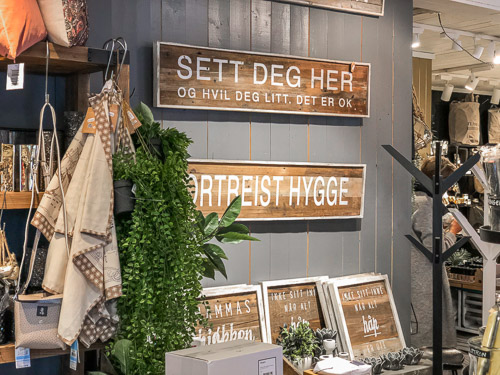

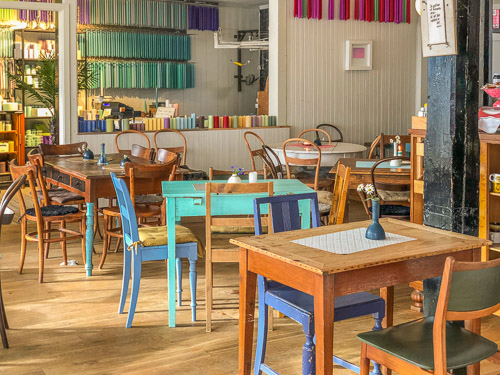
We fired up our Geocache app and were led to us some amazing locations around Henninsvær.
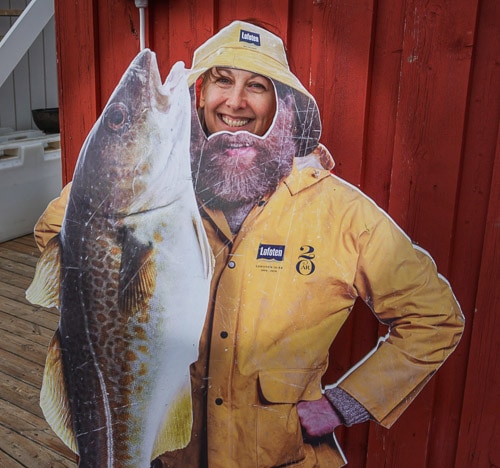
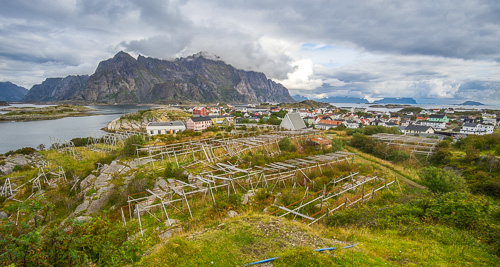
Henningsvær ©Lifejourney4two
Lysvoldbrygga’s verandah has a northerly aspect and an uninterrupted view of the nearby mountains. A panoramic viewpoint.
With the sun setting, the Norsk Gods again proved to be in fine spirits by allowing the Northern Lights to dance and play across the skies for us.
It was mesmerising.
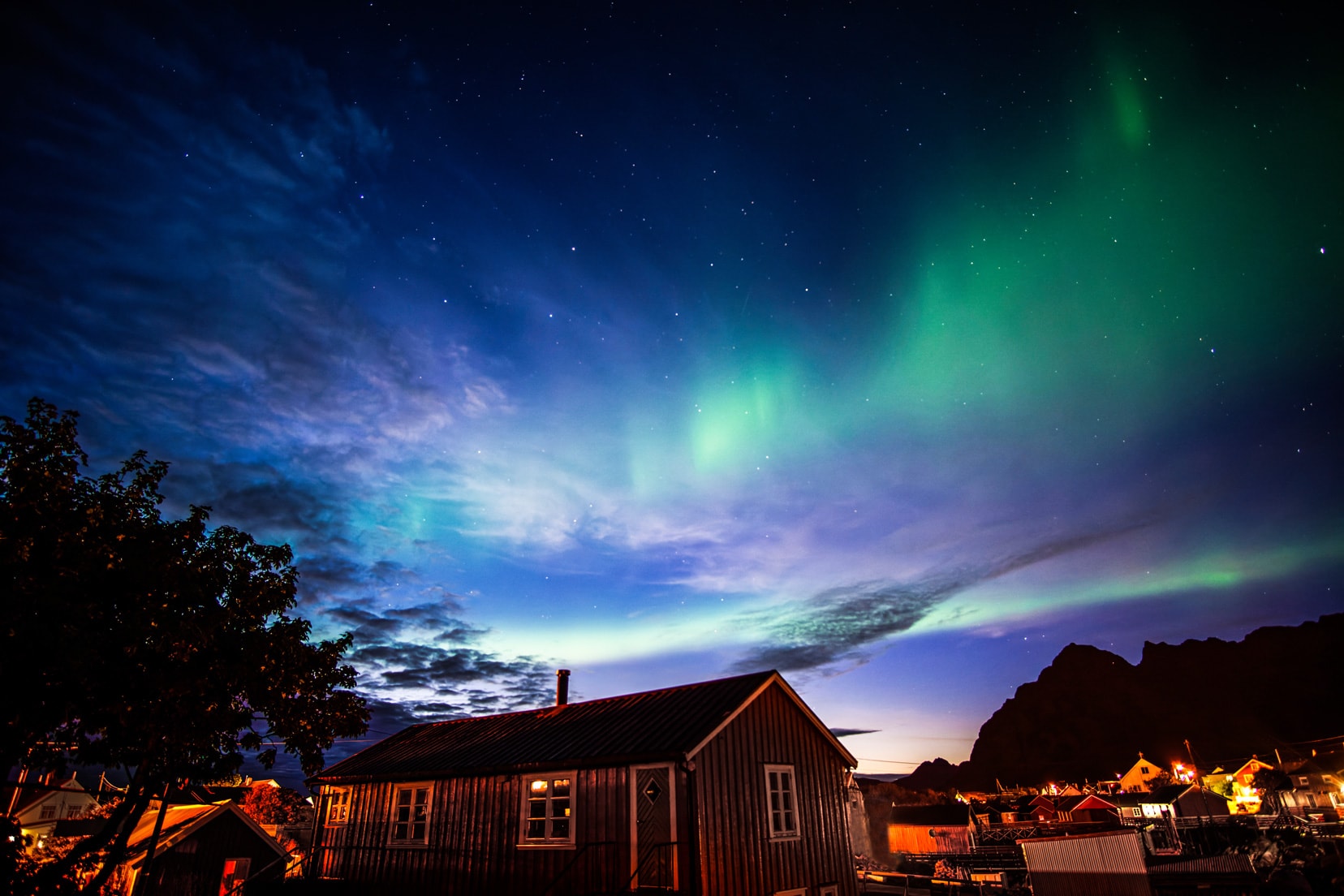
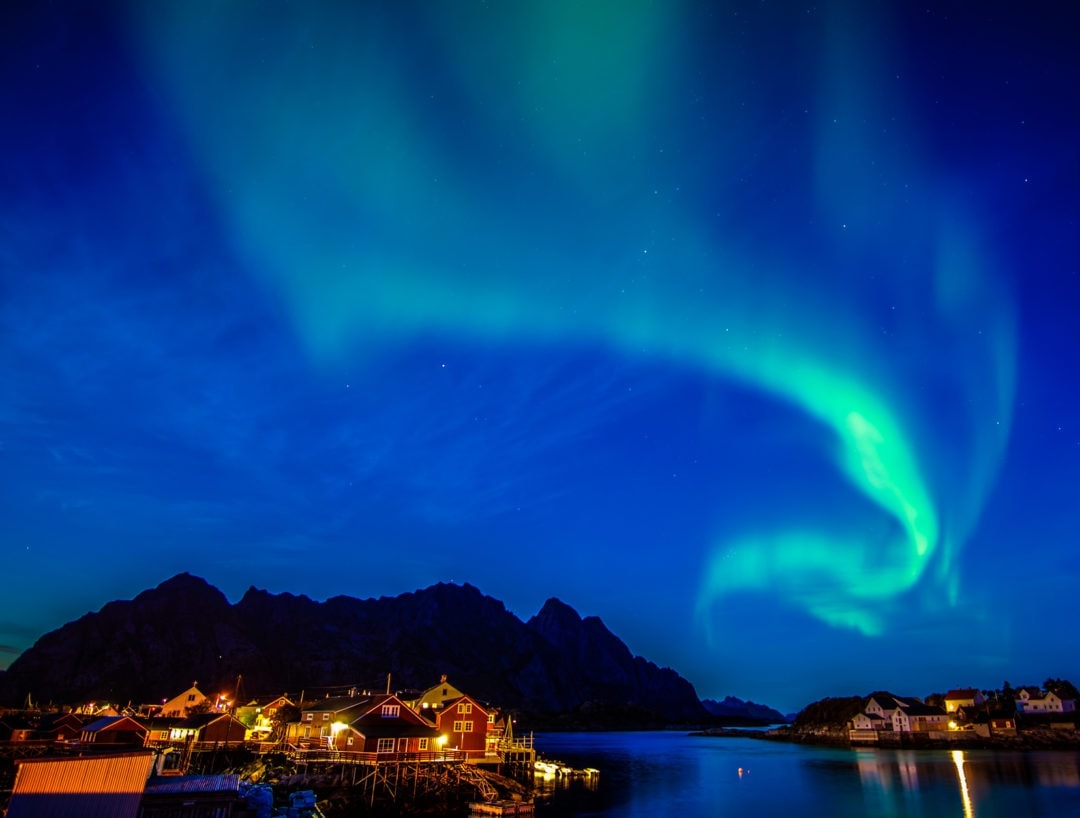
Day 5: Vågan Church, Svolvær
Total kilometres: 25 km
Overnight accommodation: Svolvær
Still ecstatic from our Northern Lights experience, we depart the serenity of beautiful Henningsvær and continue east. The first stop of the day is just 20 kilometres away.
Købelvag
The Vågan Church, also known as the Lofoten Cathedral, is a late 19th-century church and the largest in northern Norway. It can seat 1200 people and is located in Lofoten’s ancient capital, Købelvag.
A church has always claimed this position, dating back to the 12th century. The church was often sought out by visiting fishermen for blessings before undertaking the winter’s fishing in the turbulent seas.
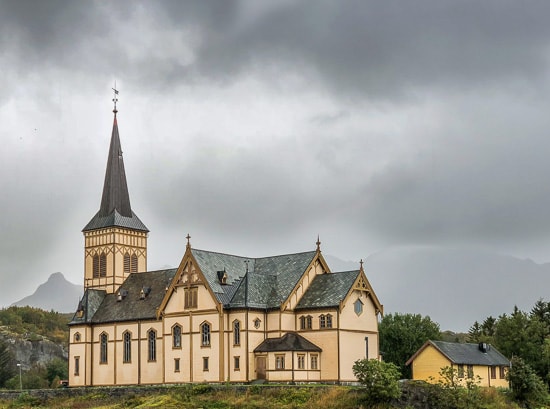
Svolvær
A few kilometres drive away, the metropolis of Svolvær appears. This is a large, well-serviced modern town.
Entering the town is stepping right back into the mainstream 21st century. It’s a busy hub, and rightly so, as Svolvær is the administrative centre for the region.
You might even call Svolvær the Oslo of the North, with its many shops selling various products. It’s definitely the best-serviced town in Lofoten.
We used Svolvær to stock up on food and source some hiking boots.

On the outskirts of Svolvær is the famous Svolværgeita or Svolvær Goat, where you can jump from one granite mountain tip to another. Resembling goat horns, so can see how they got their name.
This wasn’t something that particularly interested us, but if you think it might be for you, then have a look at this footage first.
What does sound awesome whilst you’re in Svolvær is to join a Lofoten Islands Silent Trollfjord Cruise. Regrettably, we didn’t do it, but a slow cruise off the Lofoten Islands sounds absolutely wonderful.
This Lofoten Islands Silent Trollfjord Cruise is 3.5 hours long, rated ⭐️ 4.5, is wheelchair accessible and has great customer reviews.
Optional Extra: 2 Days in Vesterålen Islands
Day 6: Nyksund
Total kilometres (Svolvær → Bø → Nyksund): 339 km or (Svolvær →Nyksund): 164km
Overnight accommodation: Nyksund
Vesterålen is much less frequented than the popular Lofoten islands. Here, you’ll enjoy wide open spaces, relatively flat land, and plenty of quiet.
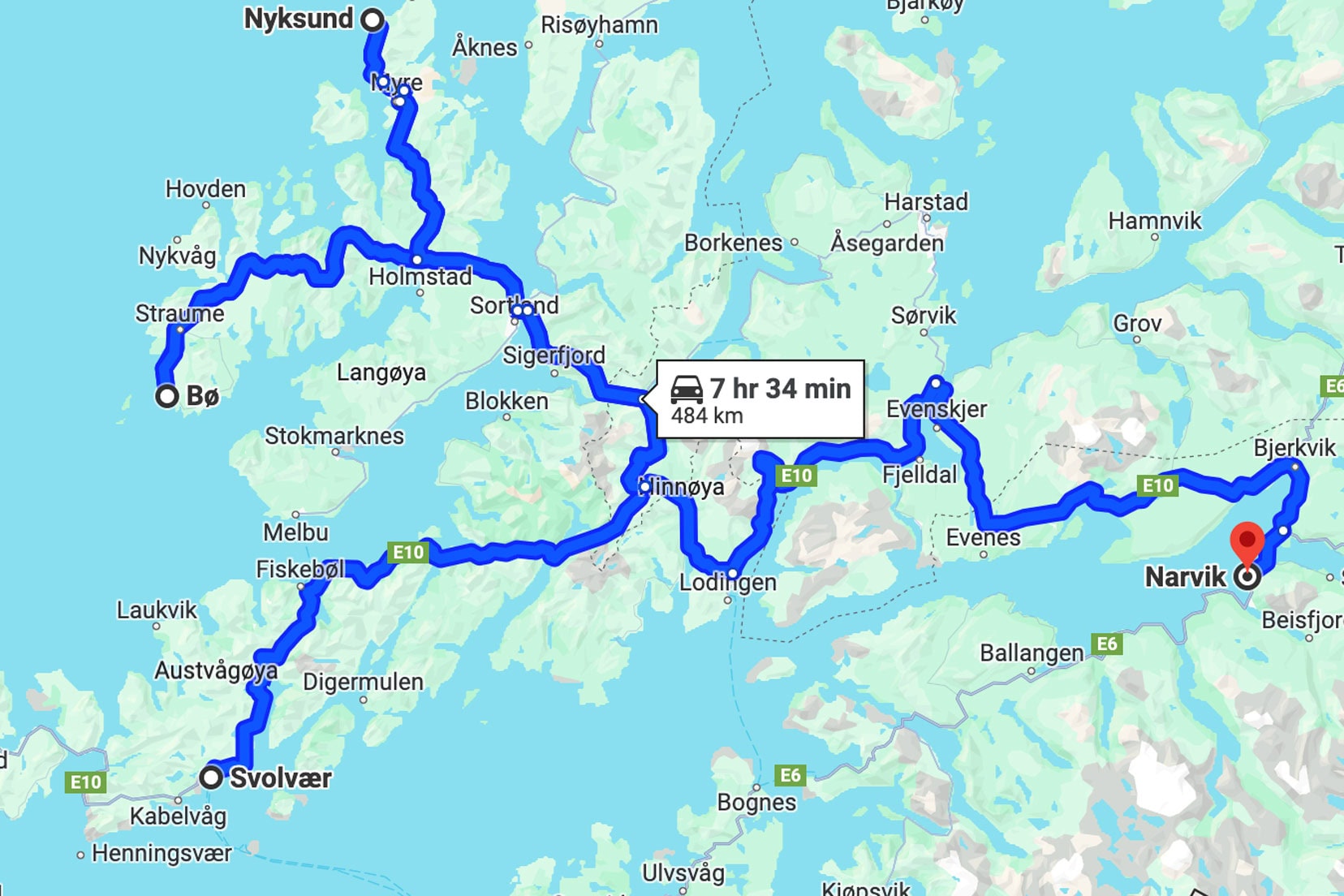
Departing Svolvær, we drove east on the E10, completed the last 62km stretch of the Lofoten Scenic Route to Raftsundet, and then turned north into Vesterålen—firstly, a visit to Bø, then onto Nyksund.
Our reason for detouring to Bø was to view another of the Artscape Nordland sculptures. However, you could easily avoid Bø and drive directly to Nyksund, which would shave off 90 km.
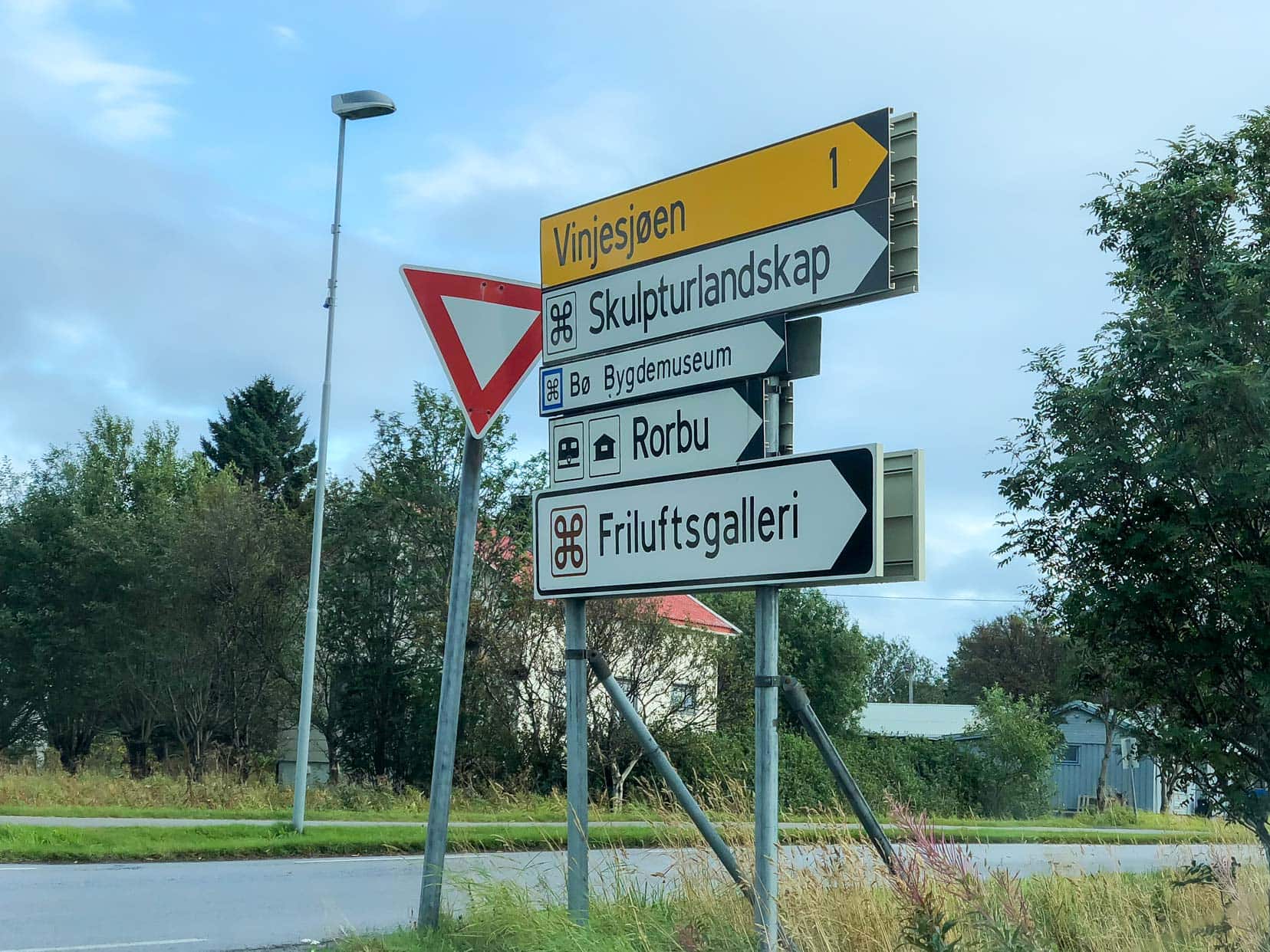
Bø
On the far west coast of Vesterålen, on the island of Langøya, is Bø, where you can find one of Skulpturalandskap Nordland’s famous works of art—The Man from the Sea.
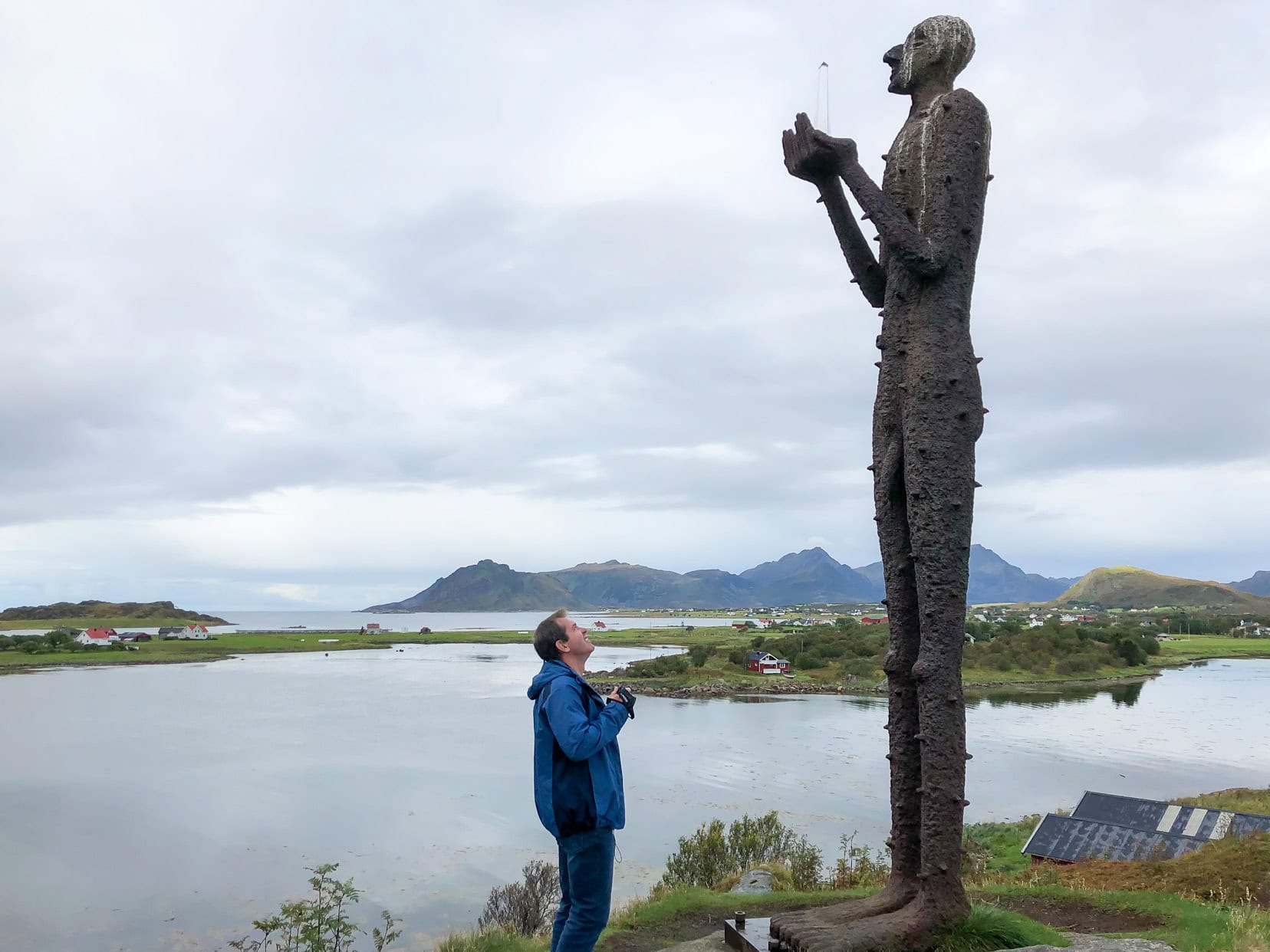
The Man from the Sea sculpture is definitely impressive, and rightly so, as it stands at a height of 4.3m. This thought-provoking piece is wrought from cast iron and depicts a man cradling a crystal who has left the sea to now walk on land.
It commands a lofty view of the countryside.
Nyksund
Departing Bø, a 1.5-hour drive north, placed us at Nyksund, the once-abandoned fishing village, where we would base ourselves for the next two nights. A painted wooden boat filled with pretty flowers marked the entrance to the village.
We wanted to visit this once-abandoned fishing village and hike Dronningruta, The Queen’s Route.
Day 7: Nyksund
Total kilometres: 0 km
Overnight accommodation: Nyksund
Nyksund
We spent some time wandering around Nyksund and its eclectic mix of buildings now repurposed as businesses. In its heyday, at the turn of the 20th century, it was a thriving fishing community.
However, this town became less popular as a fishing hub, causing the slow decline of the village until finally, it was abandoned in 1970.
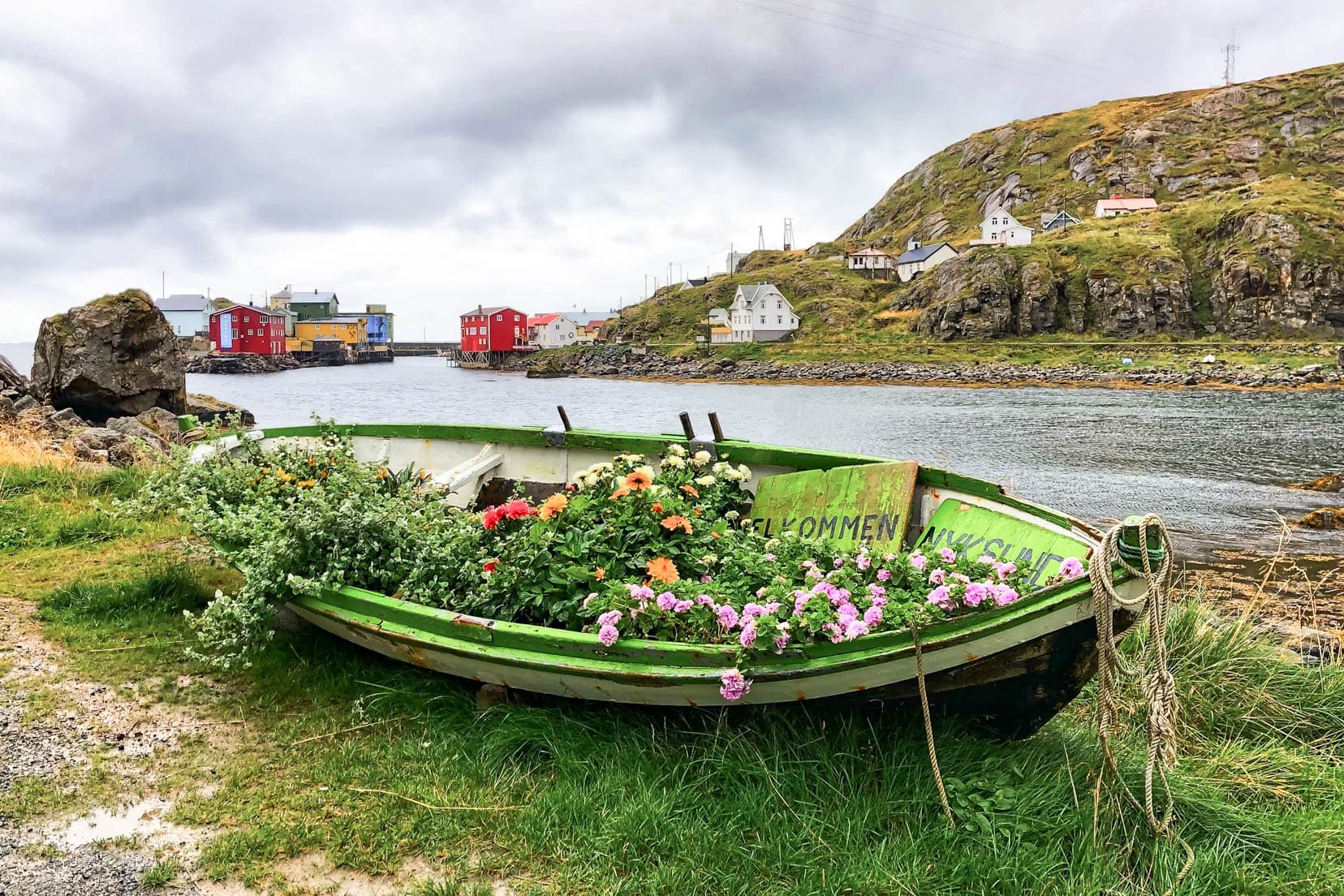
The village was revived during the 1980s, injecting life back into it. This time, Nyksund was reinvigorated by artists, cafes, the sounds of festivals, laughter, and now full-time residents.
Tourism continues to contribute to its revival, with many interesting activities on offer, a big draw being the Dronningruta hike. If you choose to do this hike, you’ll need to set aside about 6 hours; however, you might decide otherwise and depart for Narvik, 225km away.
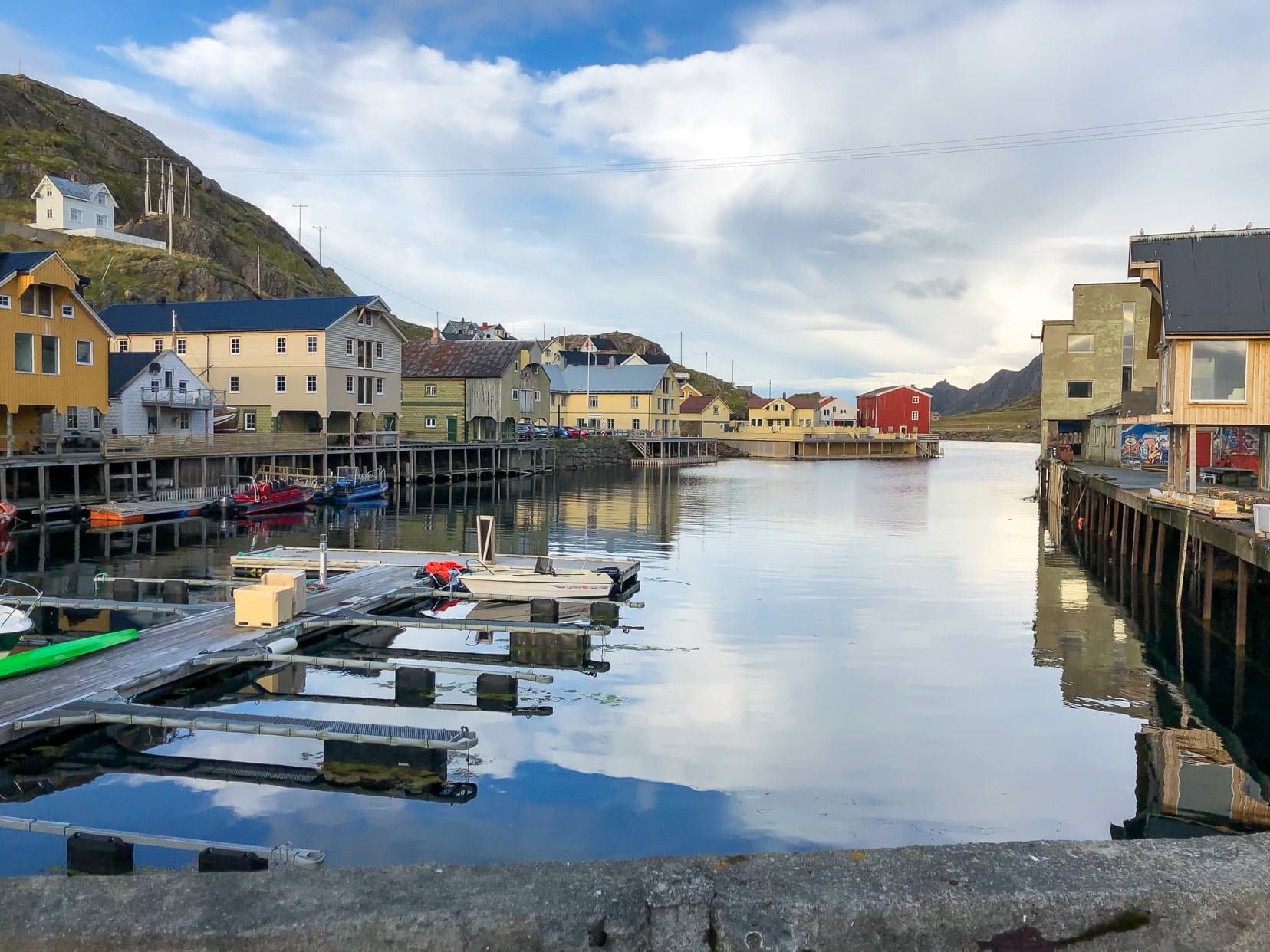
Before departing Nyksund, we took a last look at the village. We were searching for a small sculpture from Skulpturalandskap Nordland that was in the heart of Nyksund.
We had to look hard. I’ll not say more about ‘where it is,’ but here’s a spoiler photo below—there’s a face pattern on that lamp cover.
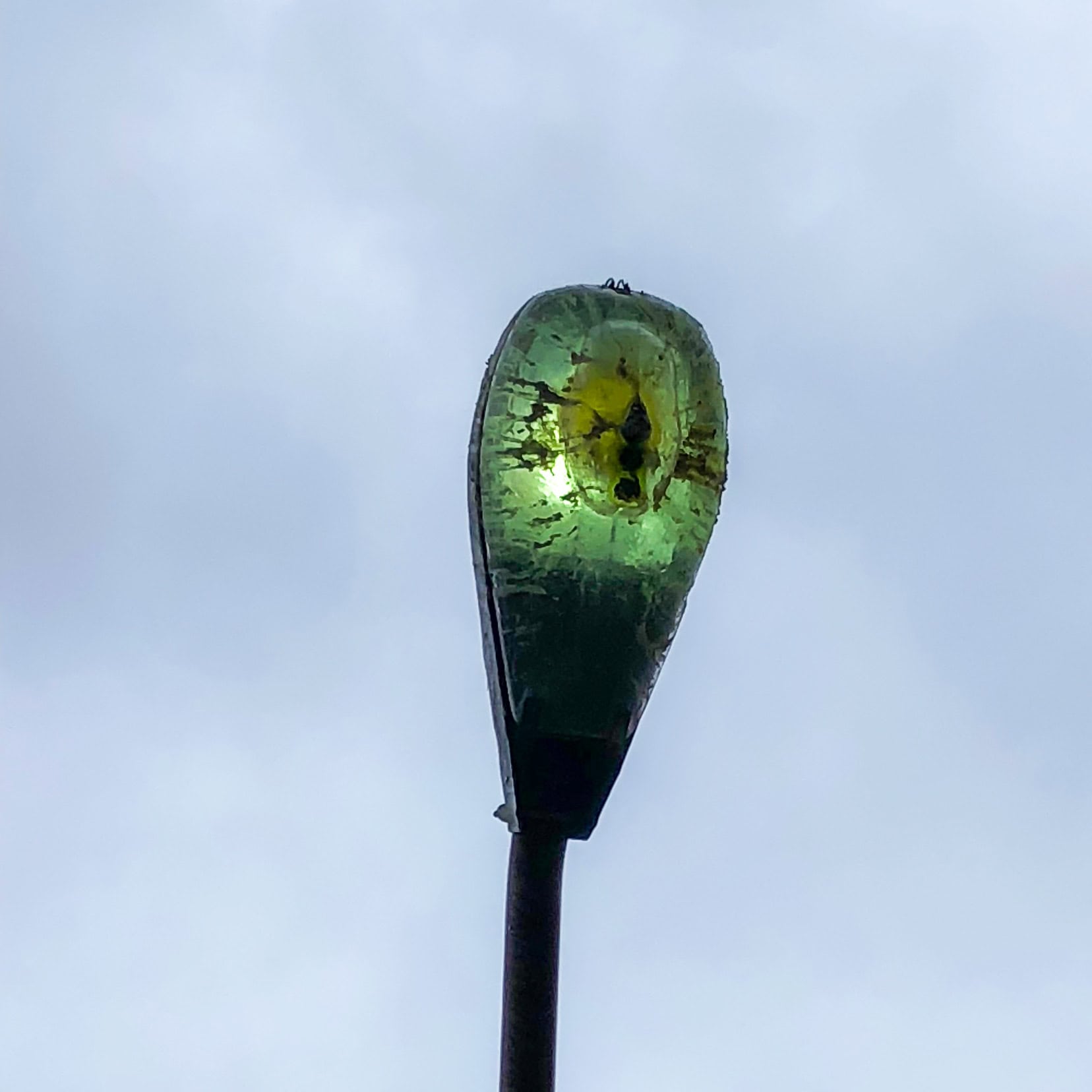
Dronningruta Hike
Nyksund also marks the start point for the gruelling Dronningruta hike otherwise known as The Queen’s Route. It has a high or red level of difficulty.
This is a demanding 15-kilometre hike over all types of mountainous terrain with the typical majestic panoramas you can expect from a famous Norwegian hike. You’ll want to give yourself a good part of the day to complete this hike and enjoy all there is to see.
I hiked Dronningruta in 5 hours.
Considering the hike?
I’ve written a comprehensive step-by-step article covering everything you need to know: Dronningruta Hike – The Queen’s Route.
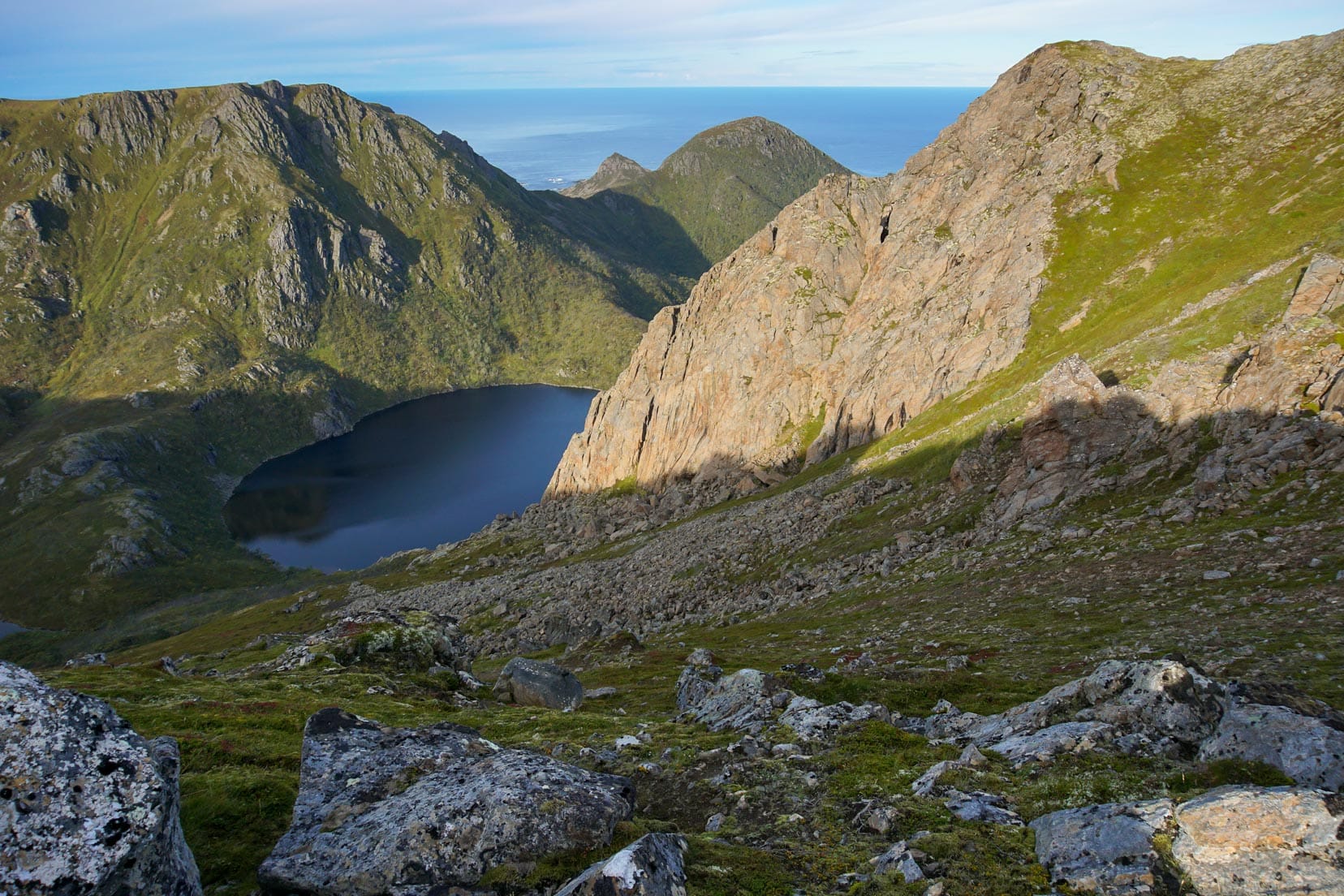
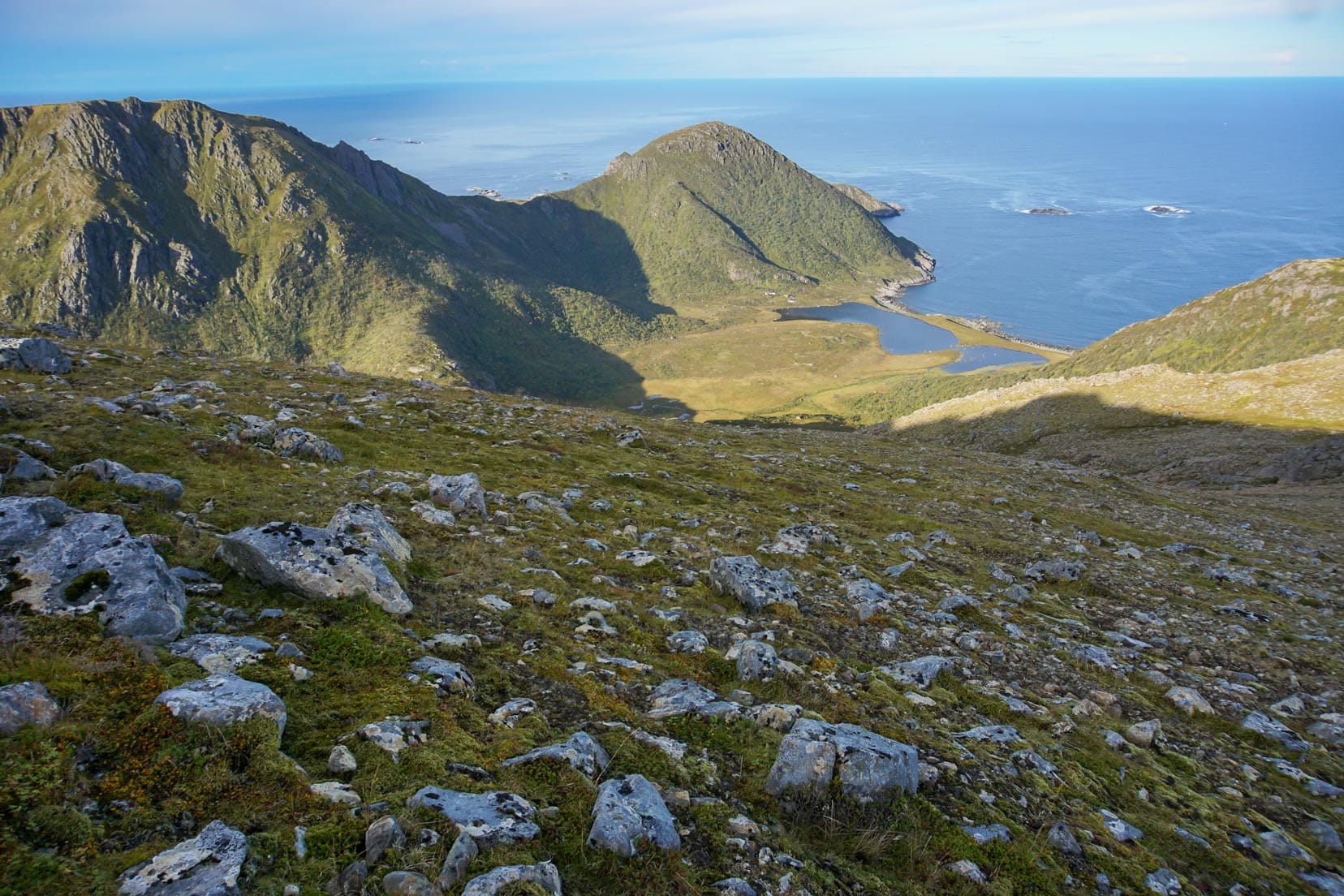
Our accommodation at Holmvik Brygge was great. Big rooms, fast internet and full amenities in the room.
Day 8: Nyksund to Narvik
Total kilometres: 225 km
Overnight accommodation: Narvik
The final drive from Nyksund to Narvik was a steady 3.5 hours. Narvik would be a convenient location to end your Lofoten road trip or, as we did, continue and enter Sweden.
First, we needed to get our heads down for some much-needed sleep.
Planning Your Lofoten Road Trip
Understanding when to visit Lofoten can greatly enhance your experience, as each season offers unique opportunities and challenges.
We visited in mid-September (Autumn), a great time with moderate weather, fewer visitors and ample daylight for outdoor activities. Importantly, it also coincides with the period when the Northern Lights were visible, and we had some wonderful sightings.
Just be mindful that some attractions close after the summer, so it’s worth checking the opening times before you plan a visit.
When is the Best Time to Visit Lofoten?
While there’s no definitive “best” time to visit Lofoten, each season has its own benefits.
Lofoten in Summer (June to August)
Summer provides the best weather, long days with the midnight sun, and vibrant tourist activity. However, it’s also the busiest season.
It’s all about enjoying the fantastic landscapes at this time of year, too early for the Northern Lights.
Lofoten in Autumn (September to November)
Autumn ushers in vibrant fall colours, transforming the landscape dramatically. The tourist crowds diminish, and the temperatures drop.
The Northern Lights begin to appear, making Autumn a wonderful time to visit and view this light show amidst this beautiful, rugged mountain setting.
Lofoten in Winter (December to February)
Winter can be wet, especially in November, with improving conditions in December. January to March offers the best chances for snow. This season is ideal for fishing and photography, thanks to the soft Arctic light and picturesque snowscapes.
Polar Nights start in December and last until early January, offering unique experiences and excellent opportunities for viewing the Northern Lights, particularly between September and April; as long as the weather plays by the book.
Winter coincides with the start of ‘Skrei’ or cod fishing season, a centuries-old event that continues to April. Expect numbers to swell in the Lofoten as cod spawn in the pristine waters.
Remember that tourist places may be closed during the winter, so check ahead and plan your Lofoten road trip accordingly.
Lofoten in Spring (March to May)
Spring is when the snow recedes to reveal new life, and the days lengthen. Bird watching is a popular activity at this time of year.
April typically marks the last month you can expect to see the Northern Lights.
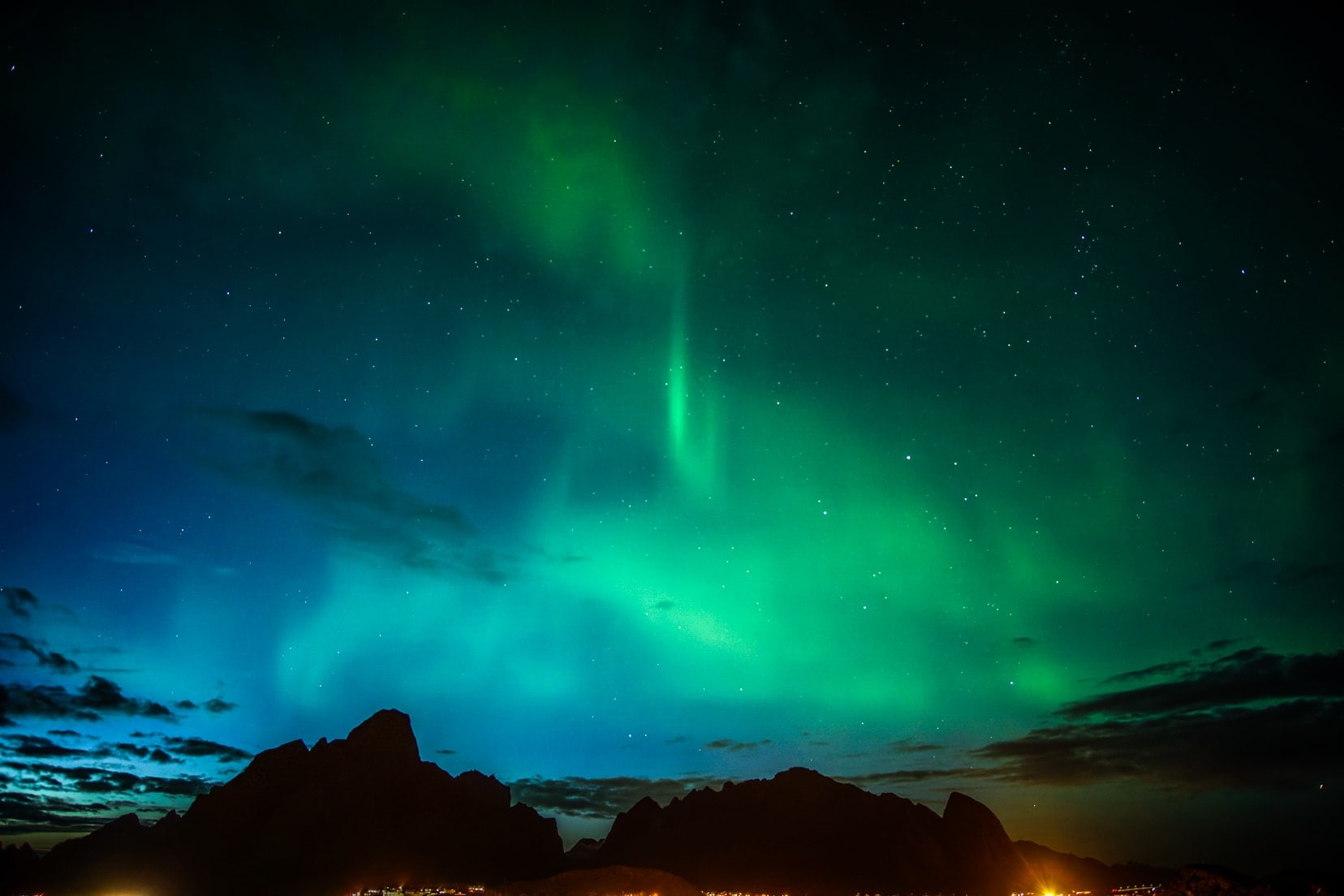
How to Get to the Lofoten Islands
Getting to Lofoten can be part of the adventure, with various options depending on your starting point and preferences. The Reis app, available for iOS and Android devices, can be used to plan journeys via Nordland public transport.
Really, the best way to get around Lofoten is to drive yourself, which is what we did, as it offers total flexibility.
By Ferry and Car
- Moskenes Car Ferry from Bodø: The Moskenes car ferry is a convenient choice for mainland people. You can choose between:
- Direct route: Bodø to Moskenes (approximately 3.5 hours)
- Indirect route: Bodø via Værøy and Røst to Moskenes (about 7 hours)
- Bookings can be made on the Torghatten Nord ferry site.
Arriving in Moskenes allows you to explore Lofoten from west to east, ideal if you continue towards Sweden. Alternatively, travel east along the Lofoten Scenic Route and return the same way.
By Ferry and Foot
- Bodø-Svolvær Ferry: Without a car, take the ferry from Bodø to Svolvær. This scenic route takes about 3.5 hours and even allows bicycles onboard, perfect for a round trip.
By Air
- Airports in Lofoten: Svolvær Airport (SVJ) and Leknes Airport (LKN) are your local options, with Leknes being the most westerly. Both airports are great for renting a car.
- Nearby Mainland Airports: Bodø Airport and Evenes Airport (EVE) in Narvik are also options.
- Drive time from Evenes to Svolvær is around 2.5 hours, and from Svolvær to Å (the westernmost point in Lofoten) is another 2.5 hours.
By Train and Ferry
- For train lovers, Bodø is the nearest train stop. From there, take a ferry to Moskenes or Svolvær, integrating seamlessly with the car ferry options mentioned above.
Lofoten Event Calendar
- Lofoten International Chamber Music Festival and Lofoten Piano Festival: Biennial classical music festivals in Lofoten. Find out more here.
- Lofoten Food Festival: Held annually in autumn, typically in September or October. More details here.
- Viking Festival: A four-day event at the Lofoten Viking Museum, usually starting in early August.
- What’s on in Vesterålen: Check for current events and activities.
- Norwegian National or Constitution Day: Celebrated across Norway on May 17, marked by extensive festivities.
Popular Lofoten Activities
Getting Around Lofoten: Transport Options for Your 5-Day Road Trip
Self-drive is definitely the way to go for your Lofoten road trip. You have the freedom to go where you want when you want. We motorhomed around Europe for a year; it was great fun and the best way to travel.
Public transport does service some of these places, but honestly, a rental car or campervan hire will get you mobile and allow you to pick the perfect travel routes that suit your plans.
Car and Motorhome Rental
Discovercars.com gave us the best car rental deals in Europe.
Motorhome Republic found us the best campervan hire deals for our year-long European road trip. Honestly, they found better pricing than we could find going direct, making the process much easier.
Why do we recommend them? I contacted exactly the same vendors and couldn’t beat their pricing. Yep, true story.
🚘 If you are looking to hire a car then we recommend DiscoverCars.
- They are winners of the World’s Best Car Rental Booking Website
- They have a Price Match Guarantee.
- 4.5 Rating on Trustpilot
- Free Cancellation
Driving in Lofoten
The maximum speed limit in Norway on open roads is 80 km/hr. Be aware that speed and trip cameras are widespread, which measure the average speed between locations. Drivers should exercise caution during their road trip lofoten.
The Norwegian Public Roads Administration website provides detailed information about Norway’s traffic regulations. For direct inquiries, contact Traffic and Road Information at +47 815 48 991.
Visit the Norwegian Scenic Routes website to check if any part of the Lofoten Scenic Route is affected during the winter.
Planning To See More of Norway?
This 5-day Lofoten itinerary concludes our series of four interconnected Norway road trip articles. This Norwegian road trip series starts in Stavanger and concludes in Lofoten and Vesterålen islands.
Heading South: You’ll want to read our Trondheim to Bodø road trip article.
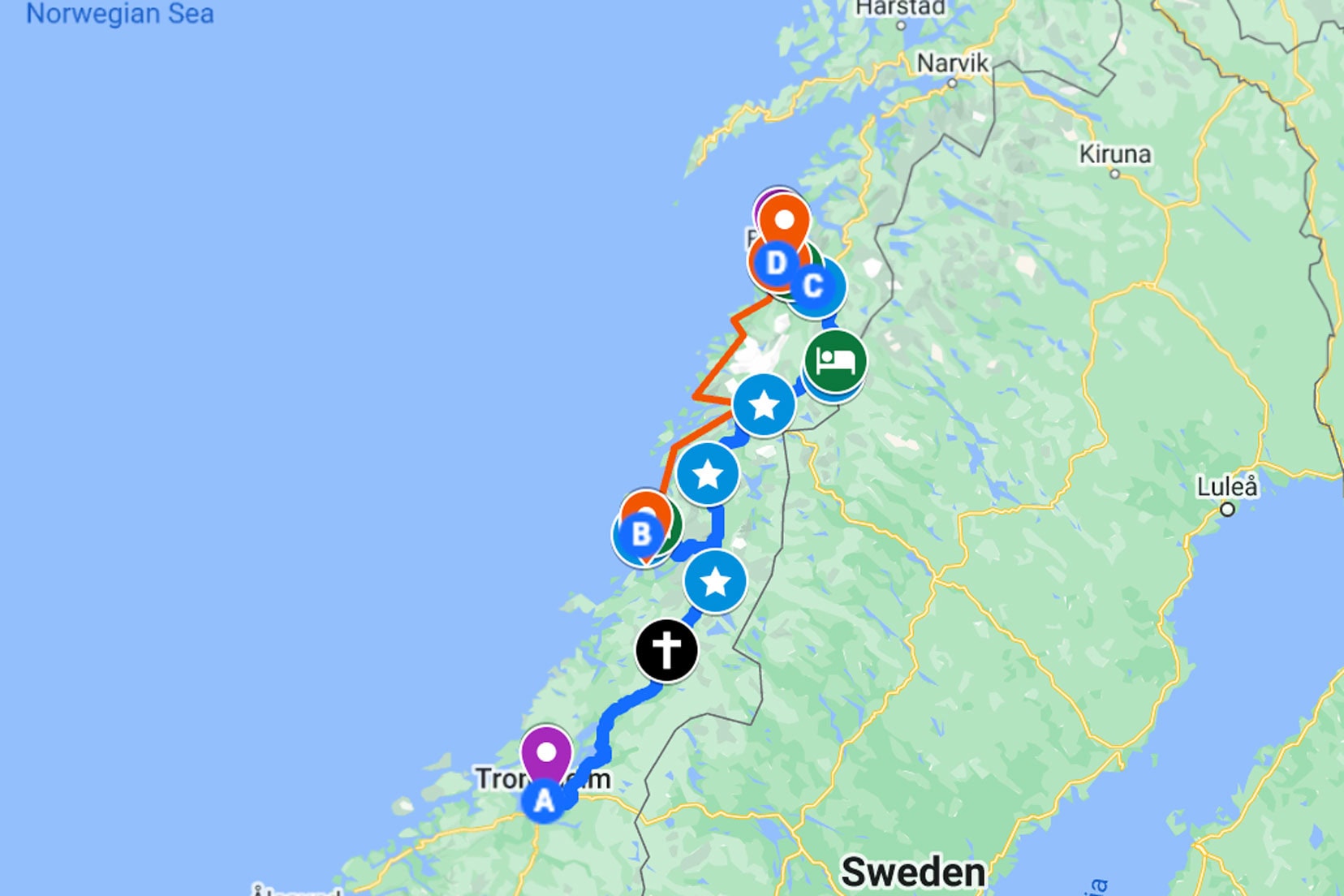
Further South: Our Bergen to Trondheim road trip article is packed with great things to see.
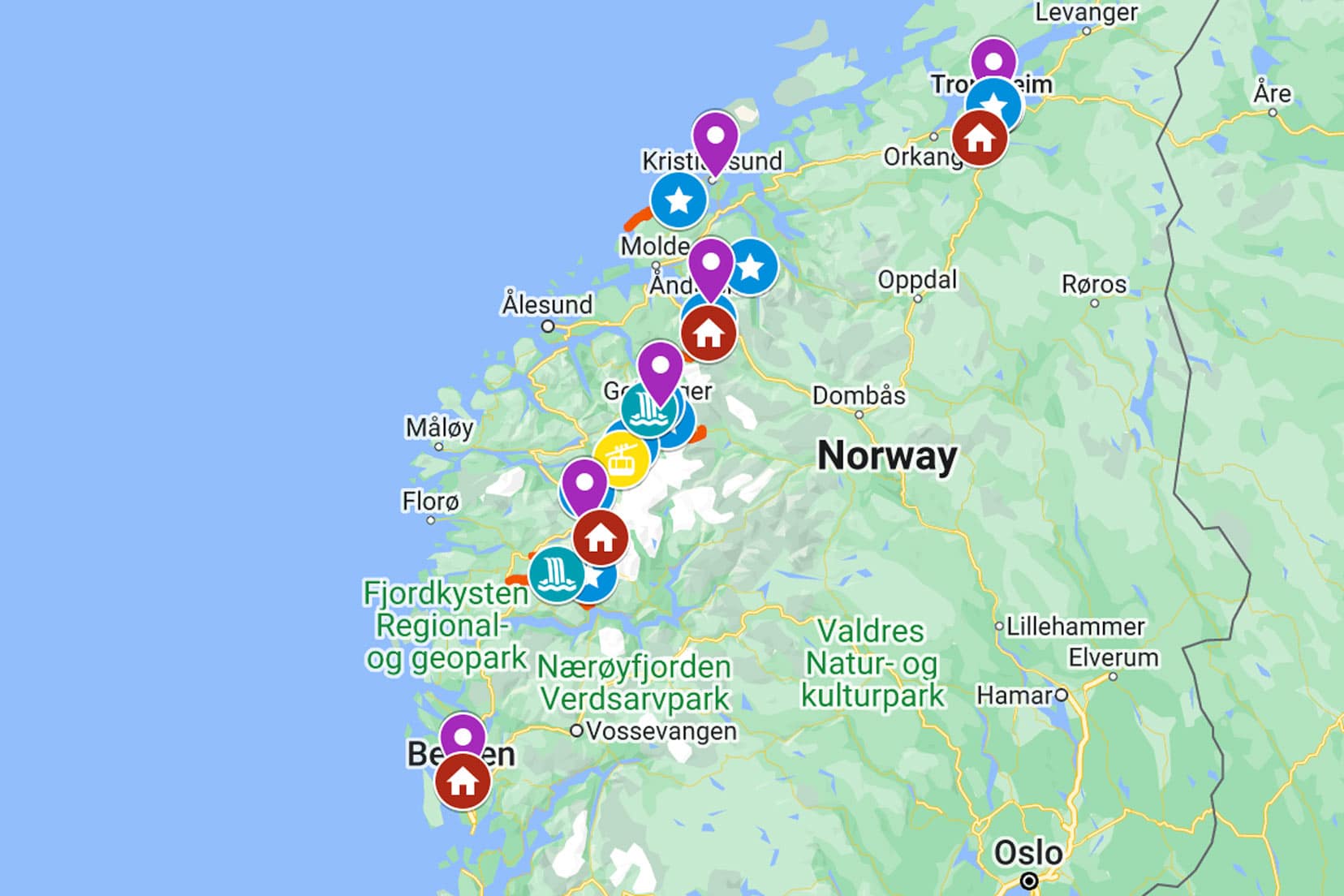
Keep Heading South: Our Stavanger to Bergen Road Trip captures the essence of Norway.

We visit iconic locations and also off-the-beaten-track spots that you may have heard about, such as Norway’s stave churches, hiking Preikestolen and seeing Kjerag’s bolt in the rock, traditional villages like Skudeneshavn and Norway’s very own Torghatten mountain with a hole.
There’s something for everyone in Norway.
Frequently Asked Questions
1. How long does it take to drive the Lofoten islands?
Following the Lofoten Scenic Route from Å (westernmost point) to Raftsundet (easternmost point), the 190 kilometres will take around 3.5 hours.
2. What are the best months to go to Lofoten?
Although Summer provides the best chances for fine weather and long daylight hours, it is also the busy tourist season. Also, to see the Northern Lights in Lofoten, a trip needs to be planned between September and April.
3. Can you drive to Lofoten?
Yes, you can drive to Lofoten from the mainland. Narvik is the closest mainland city.
4. Do I need a car in the Lofoten Islands?
It is advisable to have a car to reach remote locations in Lofoten, which are often associated with this place’s stunning panoramas.
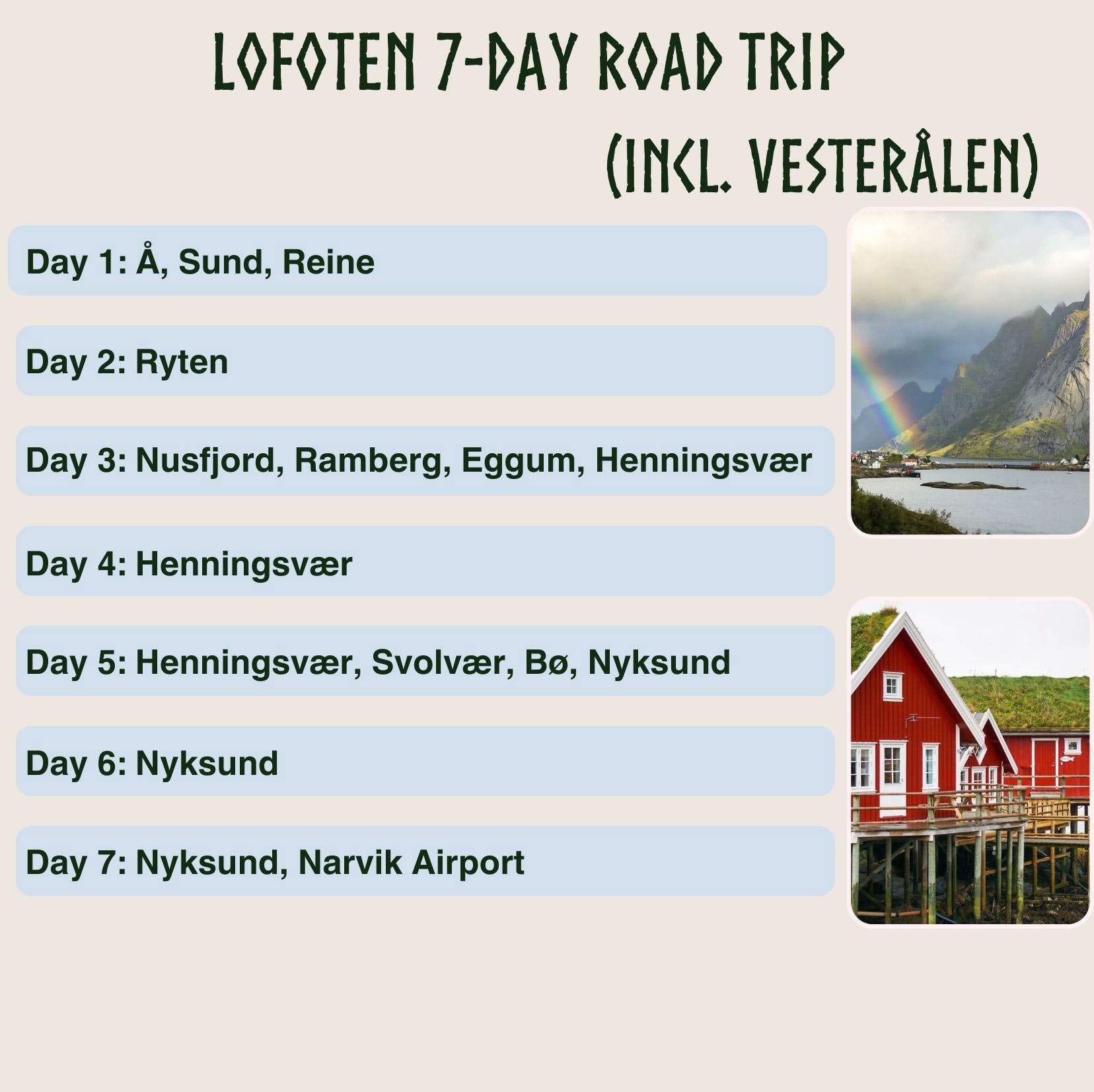
Lofoten Road Trip 5-Day Itinerary … That’s a Wrap
Lofoten Islands live up to their reputation as one of Norway’s most stunning destinations, with dramatic mountains, vibrant fjords, and the captivating Northern Lights.
Neighboring Vesterålen also captivates with its diverse landscapes—from rolling fields to rugged coastlines and challenging mountain trails.
This itinerary promises unforgettable memories. Now, it’s just a matter of deciding when to take your own remarkable journey to Lofoten.
Are the Lofoten Islands on your bucket list? Or have you visited them already? We love to hear about other people’s adventures. Drop us a comment below.
Pin and Save for Later
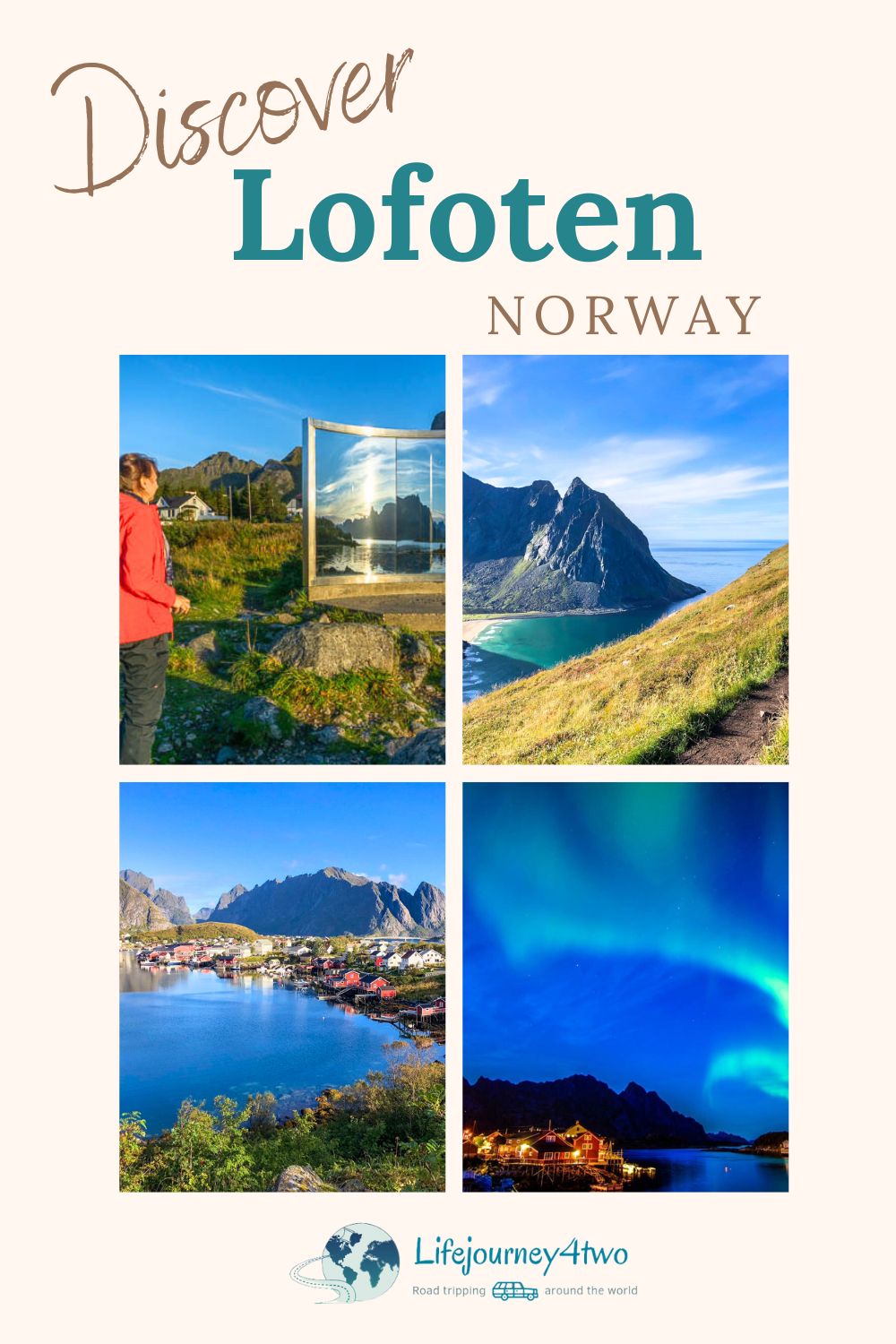
Planning Your Travels?
These are the travel resources we recommend and use when planning our trips.
- 🚘 Car Hire: We use DiscoverCars.com
- Motorhome/Campervan Rental: We highly recommend the Motorhome Republic
- 🪪 Order your International Driver’s Licence online here
- 🛏 Book Accommodation: We use Booking.com to find accommodation that suits our budget
- 🐶 Pet Sitting/Pet Sitters: Check Out TrustedHousesitters here (Use our Discount code: LIFEJOURNEY25 for 25% off. )
- Activities and Experiences: Get Your Guide and Viator
- Travel Insurance: Safetywing or World Nomads
- 🥾 Travel Gear and Accessories: Check out our top picks here — Lifejourney4two page on Amazon
For a more thorough list, visit our Travel Resources page here.

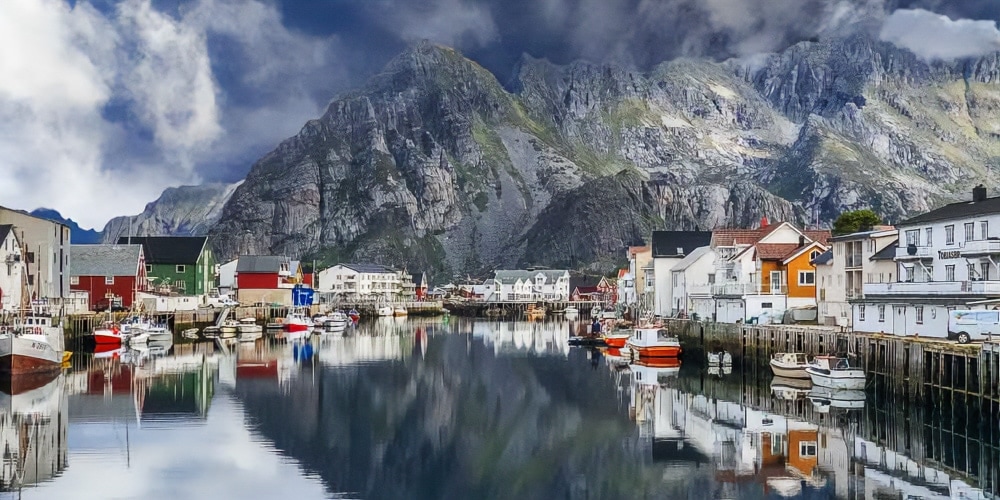
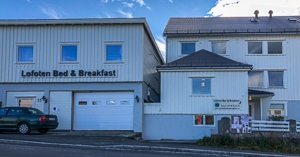
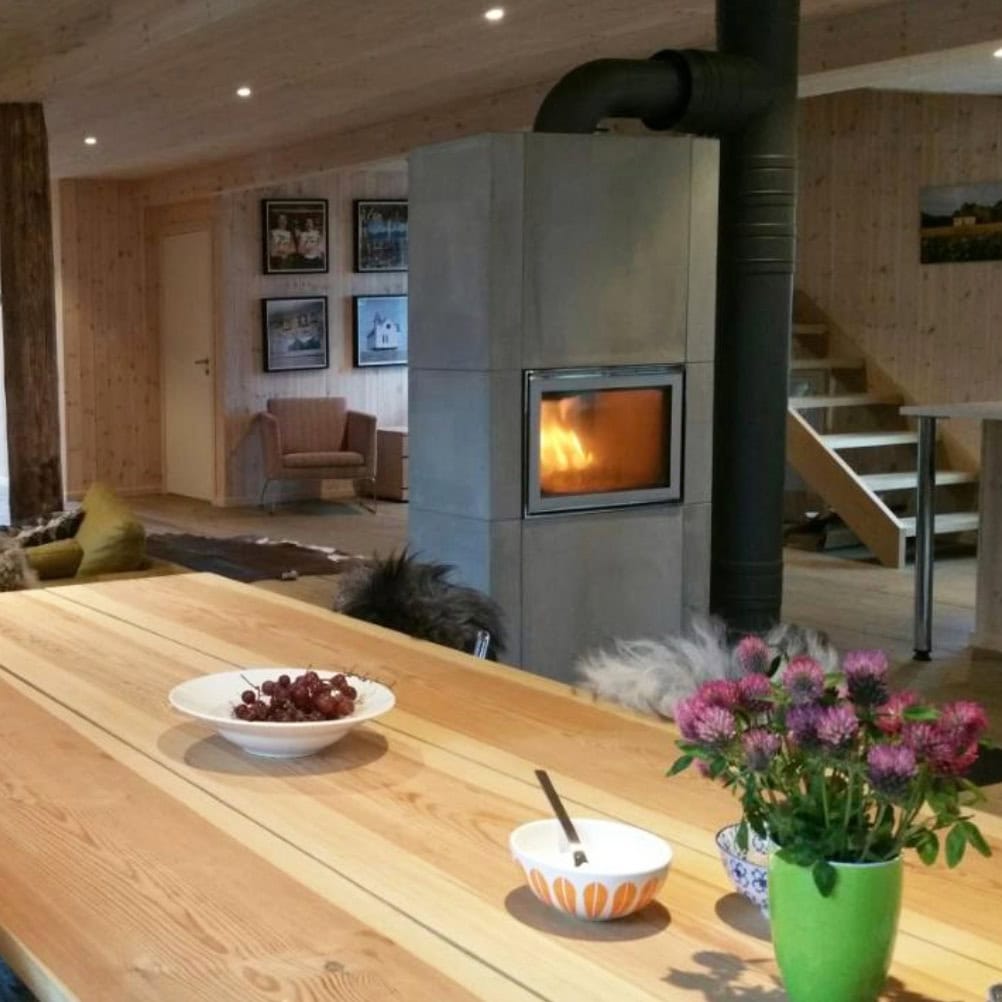
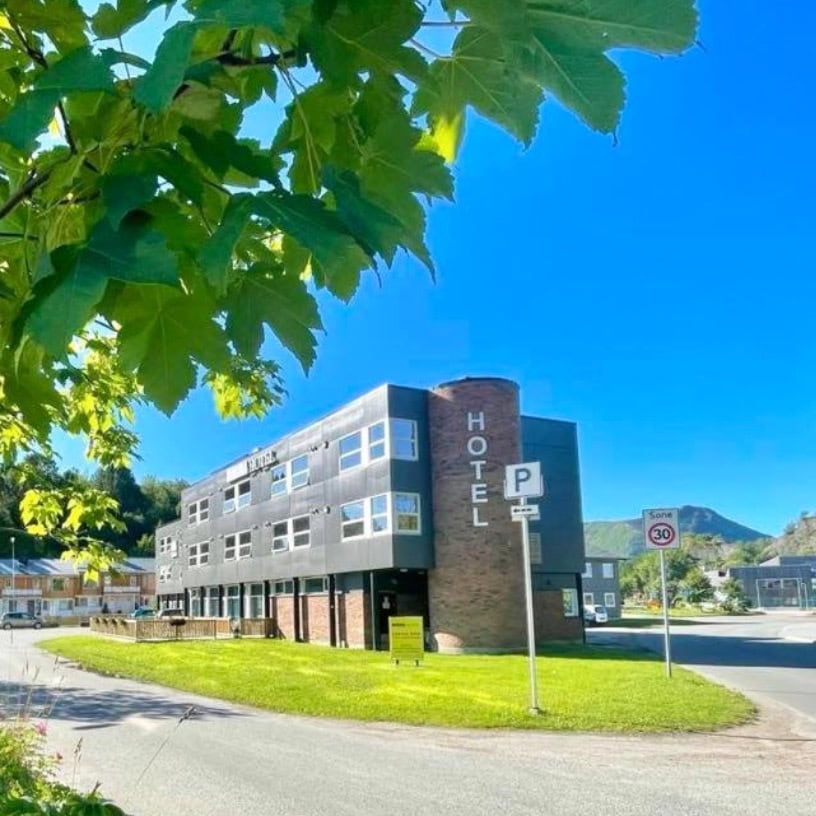
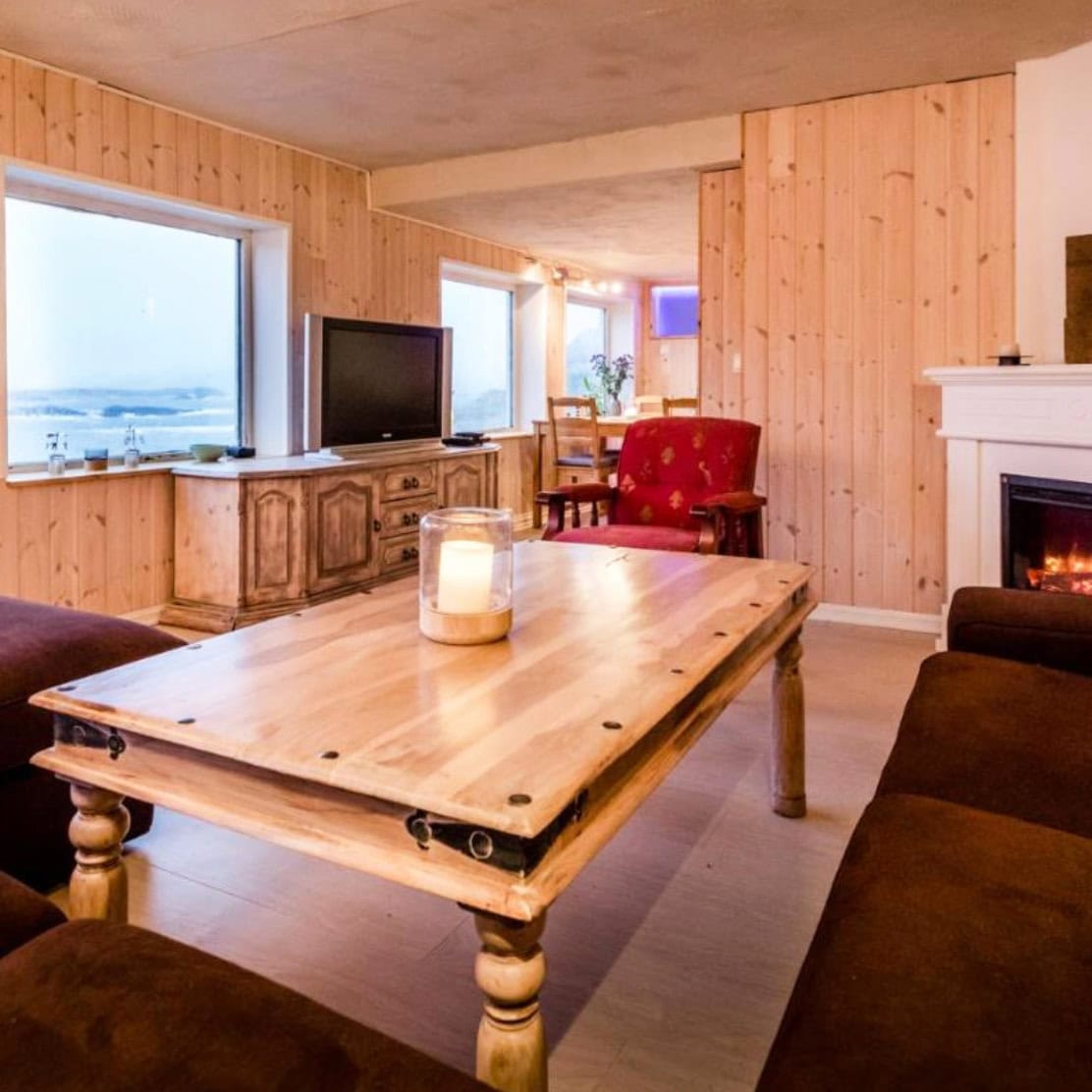
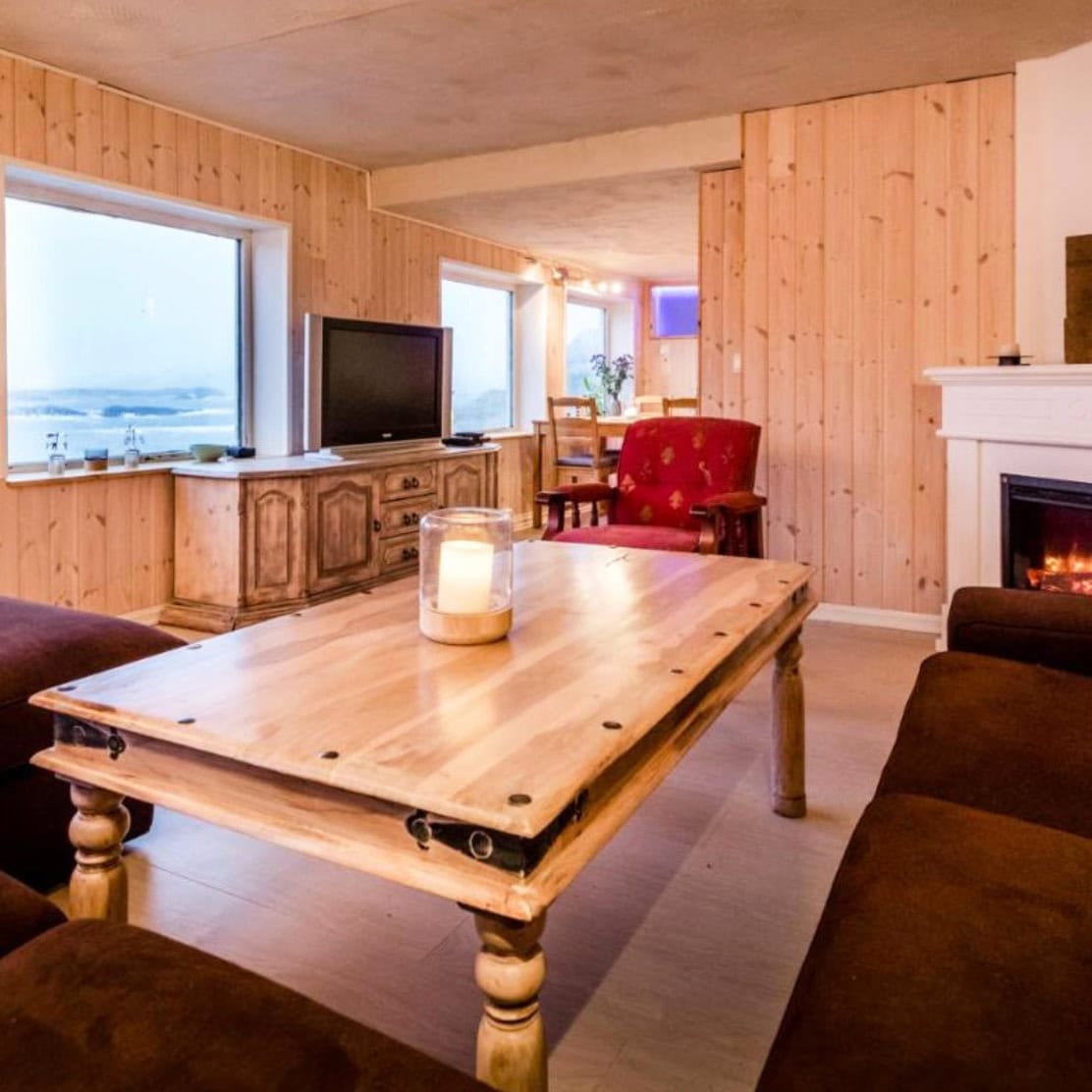
This was a fabulous read as we should have been going at the end of this month to celebrate our 30th wedding anniversary so your wonderful video was the next best thing. We are driving from Tromso to A and staying in a lighthouse a farm and a Rorbuer on our road trip. Although we won’t be going until next year we are still so excited 😃
Hi Angela, wow 30 years – congratulations! Lighthouse accommodation is so different and what a wonderful idea. Lofoten scenery is spell-binding especially the closer to get to Å. Hopefully, the Northern Lights will join you. The wait will be worth it!